Looking for a way to make your lawn or garden more attractive? Along with trees, flowers, and bushes, you can consider planting ornamental grasses.
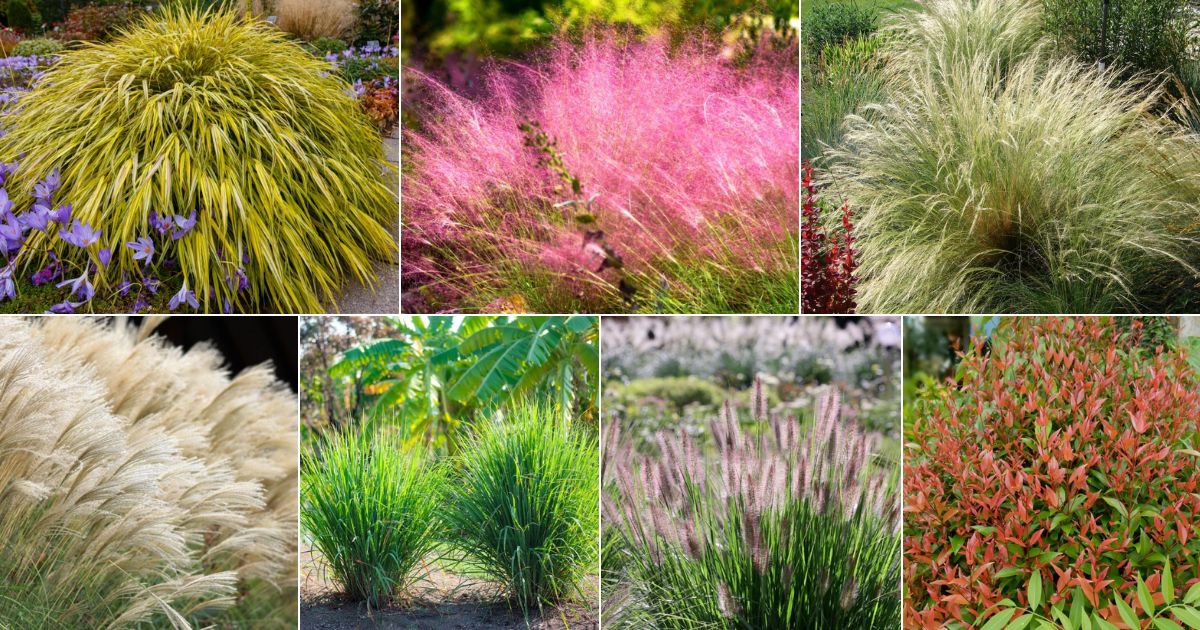
In this guide, we will introduce you to some beautiful ornamental grasses to consider planting in your yard.
First, let’s talk a little bit more about what ornamental grasses are and why you might consider growing them.
Jump to:
- What are Ornamental Grasses?
- Why Grow Ornamental Grasses?
- 24 Ornamental Grasses to Grow in Your Yard
- 1. Little Bluestem
- 2. Black Mondo Grass
- 3. Feather Reed Grass
- 4. Switch Grass
- 5. Japanese Forest Grass
- 6. Sunset Glow Bamboo
- 7. Blue Oat Grass
- 8. Adagio Maiden Grass
- 9. Black Bamboo
- 10. Purple Millet
- 11. Gulf Stream Heavenly Bamboo
- 12. Cord Grass
- 13. Lemon Grass Plant
- 14. Fiber Optic Grass
- 15. Northern Sea Oats
- 16. Ravenna Grass
- 17. Edible Bamboo Plant
- 18. Golden Bamboo
- 19. Zebra Grass
- 20. Mexican Feather Grass
- 21. Purple Moor Grass
- 22. Pink Muhly Grass
- 23. Blue Fescue
- 24. Multiplex Bamboo
- Ornamental Grasses FAQ
- Beautify Your Yard with Ornamental Grasses Now
What are Ornamental Grasses?
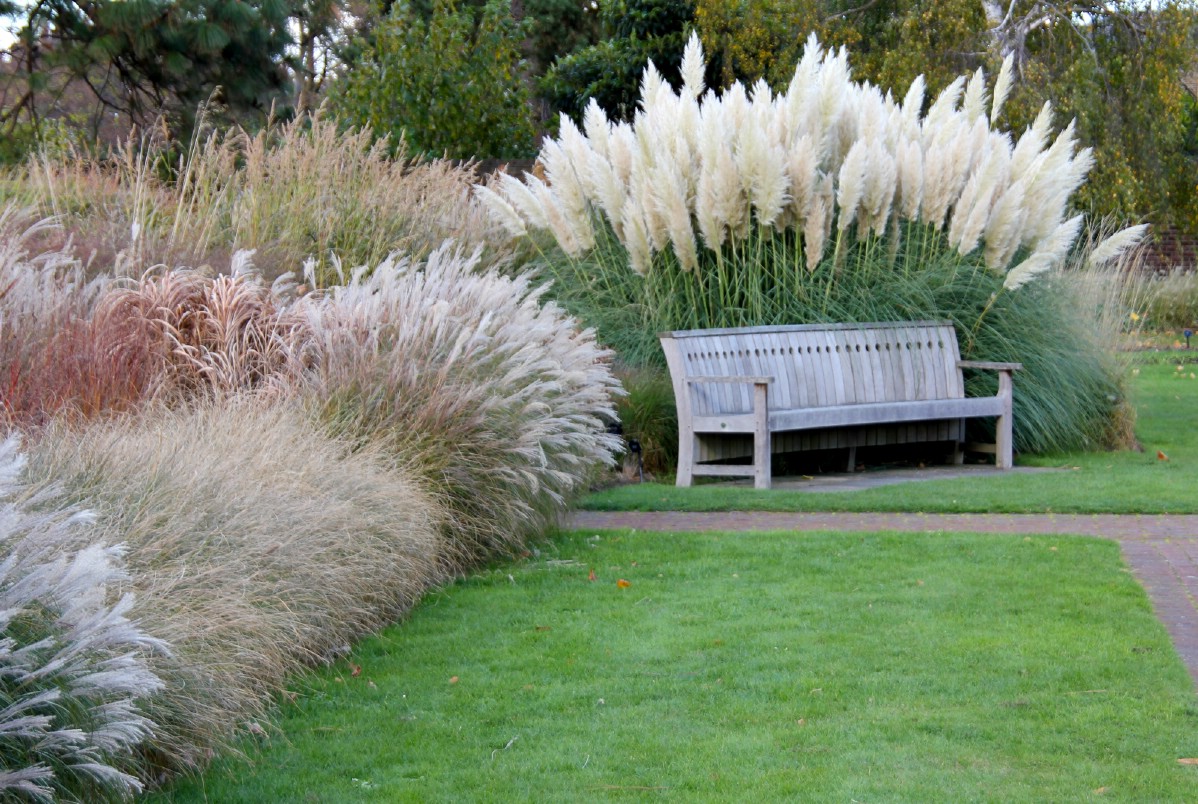
The Clemson Cooperative Extension Home & Garden Information Center says, “Ornamental grasses refers to both true grasses and plants that have a grass-like appearance, such as sedges, that are used for similar purposes in gardens.”
There are two ways ornamental grasses grow:
- In clumps
Or …
- By spreading
There are advantages and disadvantages to grasses that spread. On the plus side, you don’t have to spend much money or put much effort into getting them to cover a wide area in your yard. But the downside is that it can be hard to control them, and they can overrun parts of your garden you don’t want them in.
Why Grow Ornamental Grasses?
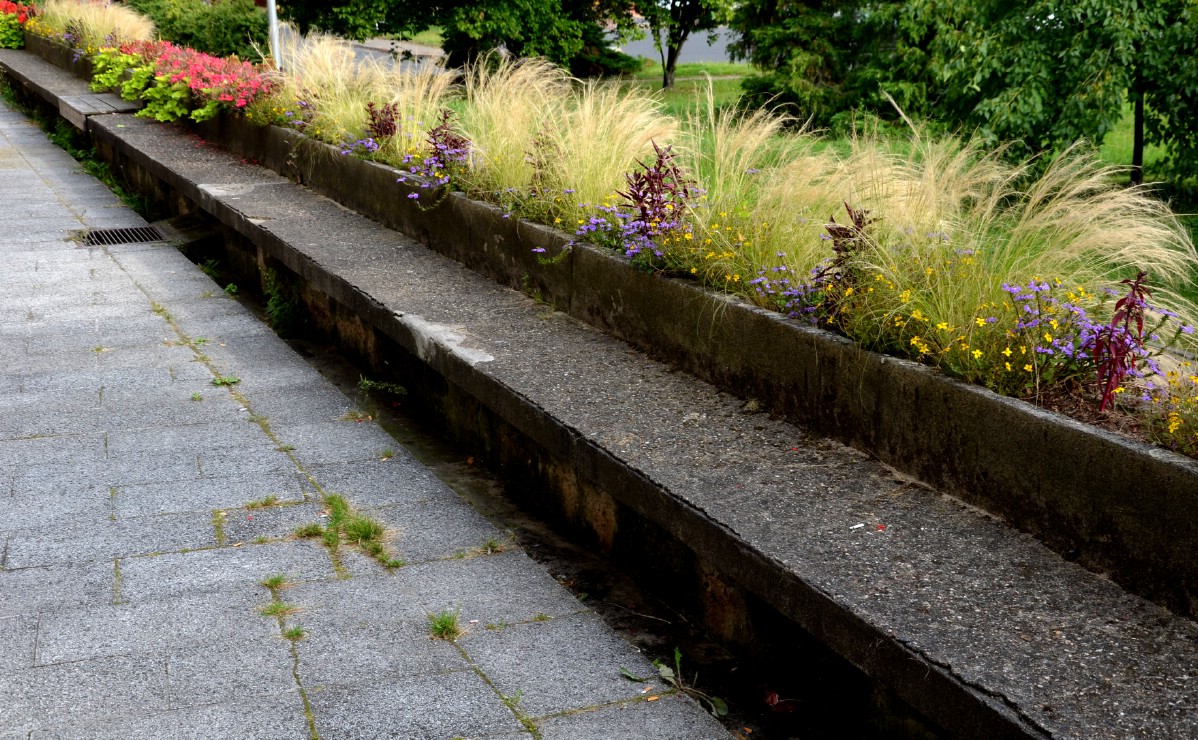
- Ornamental grasses are beautiful. Whatever textures you fancy or colors you desire, you can find grasses that will add the visual appeal you are seeking to your yard.
- You can find grasses for summer or winter or year-round. Clemson explains, “Cool-season grasses begin new growth in fall or winter and bloom in spring or early summer. They will go dormant or decline in appearance during the summer heat. Most ornamental grasses for the South are warm season growers. They grow rapidly during spring and summer, bloom in late summer or fall, and are dormant through the winter.” You also can find evergreen grasses.
- Grasses can make good privacy screens. Some ornamental grasses you can plant may reach up to 15 feet in height. If you are looking to screen off your yard from the road or from your neighbors, these grasses can offer you the privacy solution you need.
- The motion of grasses adds to their appeal. It isn’t just the static appearance of grasses that is beautiful, but also their dynamic movements. As the breeze sweeps through them, they can ripple in breathtaking ways.
- Ornamental grasses can do well in dry locations. If you have been having a hard time finding drought-resistant plants for your lawn and garden, ornamental grass is could be just what you are looking for.
- Deer don’t care for grasses. On the whole, it is rare for deer to take much interest in ornamental grasses. So, if deer keep eating the other things you plant, filling in the gaps they’ve created with some ornamental grass might work out better.
- Usually grasses are dog-safe. If you have dogs running around in your backyard, it is important to make sure that you do not plant anything that is toxic to them. The vast majority of grasses are safe for dogs and cats.
- Some types of ornamental grasses are attractive to birds. Others serve as food for caterpillars, and may thus draw butterflies.
- Many ornamental grasses are easy to grow. Quite a few ornamental grasses make good plants for beginners as they do not require a whole lot of maintenance and can tolerate a wide range of conditions.
24 Ornamental Grasses to Grow in Your Yard
Now that we have talked about some of the benefits of growing ornamental grasses, let’s take a look at some grasses to consider growing in your own yard.
1. Little Bluestem
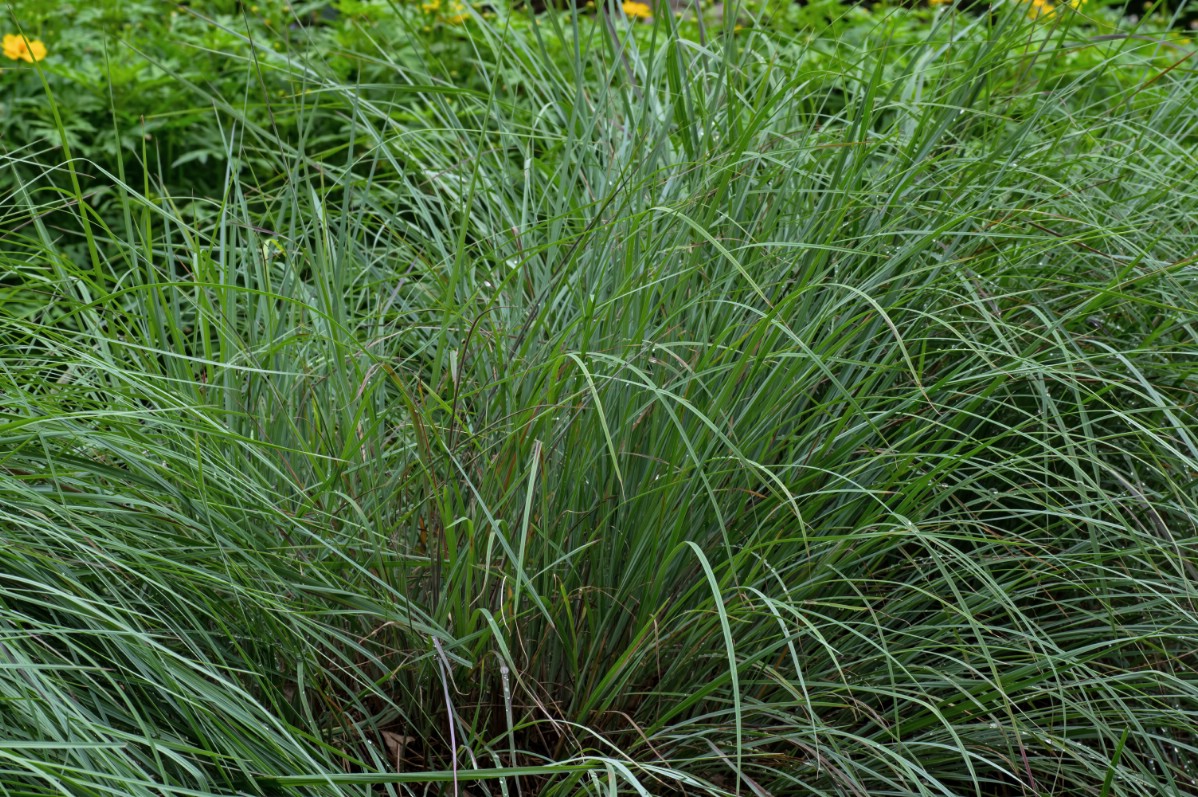
- Botanical name: Schizachyrium scoparium
- Mature height: 3 feet
- Growing conditions: 4-9
- Ideal growing zones: Full sun, well-drained soil
- Little Bluestem grass seed easily grows to produce one of the most popular ornamental grasses on the market today, and it is widely used in landscaping. Little Bluestem native grass is often used in...
- This native prairie grass has a wide range of colors which are various shades of blue and green hues. These colors turn to a striking bright red in fall and are are topped by fluffy silvery-white seed...
- Little Bluestem is a vigorous, long-lived native bunch grass, widely distributed over the United States; but most prevalent in the Central and Southern Great Plains. It is usually found associated...
- Native Ornamental grass seeds drought tolerant
This is a type of prairie grass that can be found throughout the US and in parts of southern Canada and northern Mexico. If you live in the Midwest, chances are good you have seen it at some point. Indeed, both Kansas and Nebraska have it as their official state grass. But it does not grow natively in Nevada, California, or Oregon.
As a perennial, this plant grows in mounds, with the growing season being between May and June. The colors of the blades vary between gray-green and blue-green, thus its name “Little Bluestem.”
In July, it flowers. The flower stalks can rise up to two feet above the grass blades.
During autumn, Little Bluestem loses its blue-green coloration and turns orangey with purple and red hues. You can get a deeper reddish hue if you plant it in sandy soil. Not surprisingly, it resists drought.
2. Black Mondo Grass
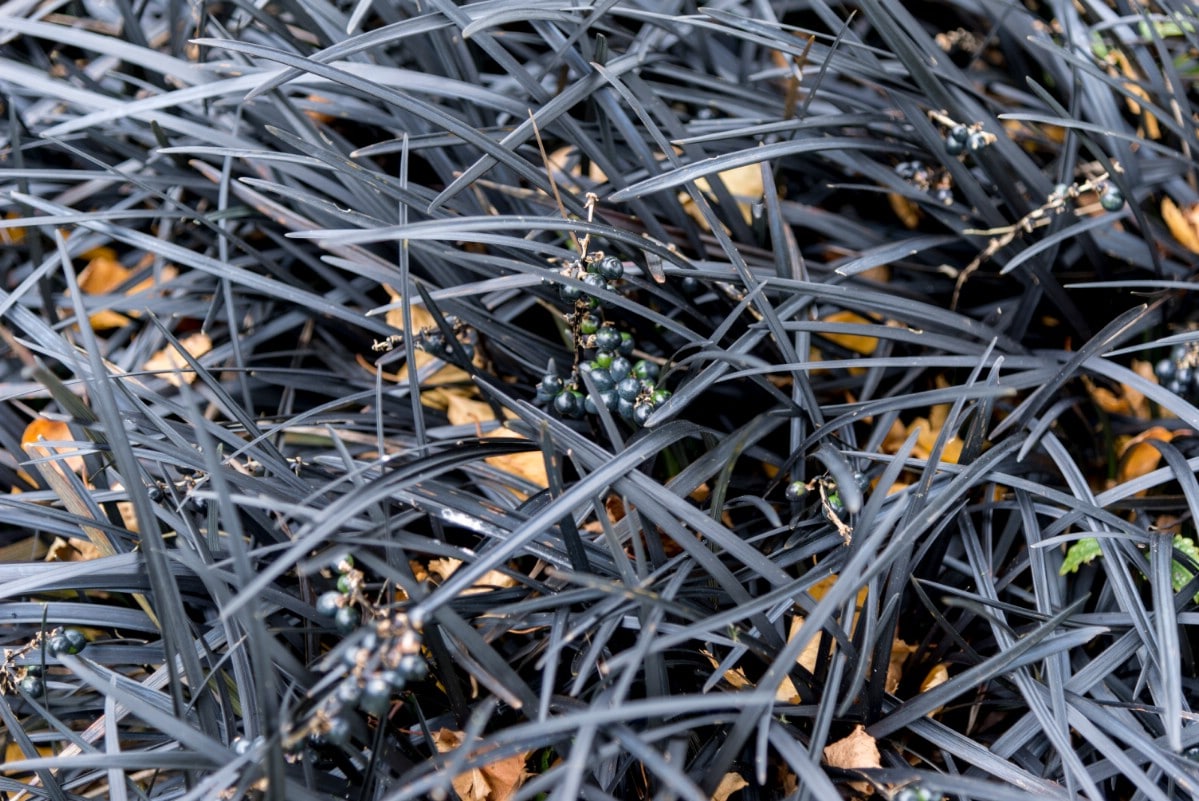
- Botanical name: Ophiopogon planiscapus 'Nigrescens'
- Mature height: 8-12 inches
- Growing conditions: Partial to full sun
- Ideal growing zones: 5-10
- This is a statement piece for your garden. It is perfect to border anything at all, and is totally striking all on its own. Its height stays at 6 inches, so it is a good plant to “put in front”....
- Items shipped bareroot. Perfect for fall and winter planting in the southernmost states with warmer, more forgiving climates.
- These need to be planted promptly! Bareroots do not have a long shelf life. Plan your planting accordingly.
- Grown, packaged and shipped exclusively by Florida Foliage. Stunning contrast for the front of the border with exceptional, dense, purple-black, grass-like foliage. Produces dark lavender flowers in...
- Ophiopogon planiscapus 'Black Dragon'' (Black Dragon Mondo Grass) Each 6" tall circular mound is composed of truly black ¼" wide foliage. Spreading by rhizomes, a single plant will make a nice 20"...
- The Black Dragon Mondo Grass is an excellent candidate for a terrarium or fairy garden.
Black Mondo Grass is a plant with a dark grayish-green color. It is not technically “black,” but can form such a dark contrast to other plants that it is hard not to think of it that way. Indeed, you can emphasize this contrast in your landscaping by planting brighter green plants around it.
In summer, this grass flowers, producing blossoms that are white or pink bell shapes. These also form a dramatic contrast with the dark green leaves. The flowers in turn produce berries.
As this grass does not grow to be very tall, it works well for lining walkways.
3. Feather Reed Grass
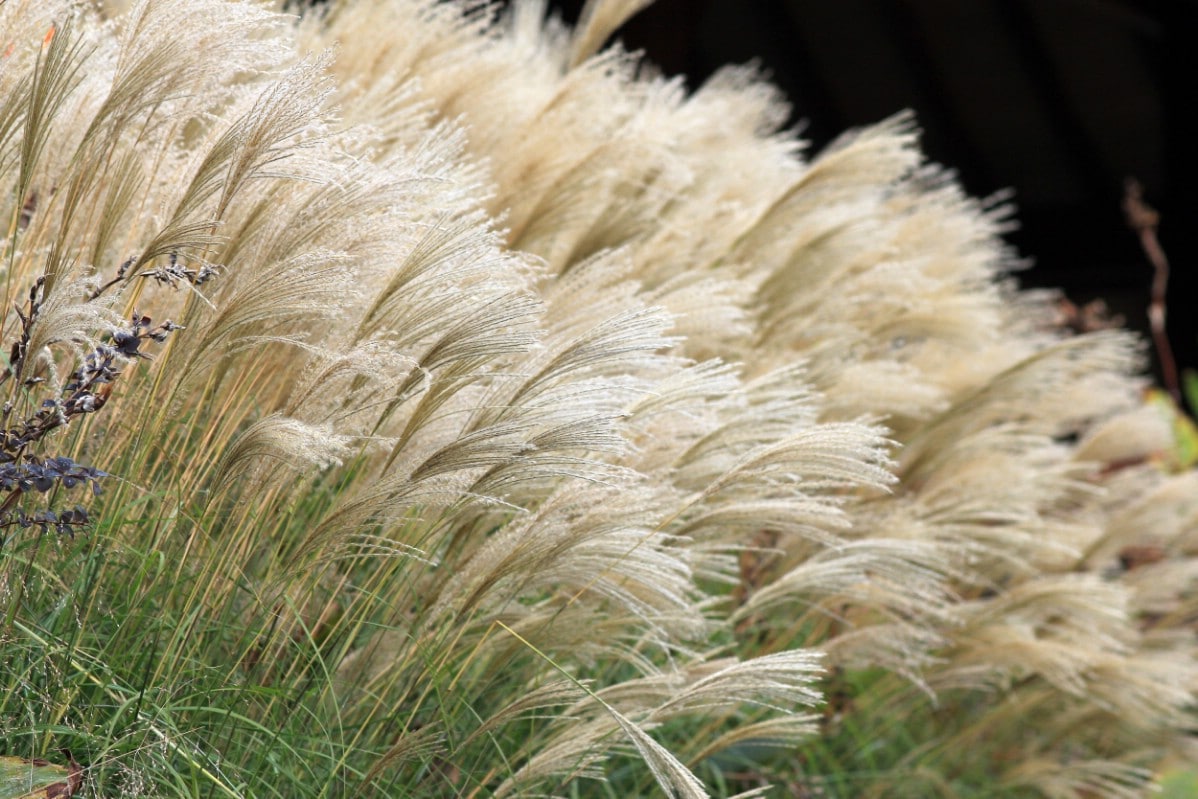
- Botanical name: Calamagrostis 'Karl Foerster'
- Mature height: 6 feet
- Growing conditions: Full sun, well-drained soil
- Ideal growing zones: 5-9
- Grown, packaged and shipped exclusively by Florida Foliage. Create a stunning vertical effect with feathery stalks that emerge reddish brown in spring and turn a rich golden color in fall. Blooms two...
- This low growing ornamental grass is colorful and ever changing. With feathery flower spikes that emerge reddish-brown in spring and turn golden to buff in fall, it adds a lovely accent to naturalist,...
- Thrives in rich, moist soils, but highly adaptable. Best foliage and plumes in full sun; benefits from part shade in hottest summer climates. Water deeply, regularly during first growing season to...
If the first ornamental grass to spring to mind is Feather Reed Grass, that is probably because few other perennial grasses are as popular as this one. It is actually a hybrid plant, produced by crossing Calamagrostis arundinacea and Calamagrostis epigejos.
Indeed, the hybrid nature of Feather Reed Grass is one of its benefits, because it produces sterile seeds. It also clumps rather than spreads, so it is not aggressive in any way.
The leaves of the grass are green, and during the summer, the plant produces long plumes of flowers that have a soft, feathery texture, thus the name “Feather Reed Grass.” These flowers have a pinkish tint to them.
4. Switch Grass
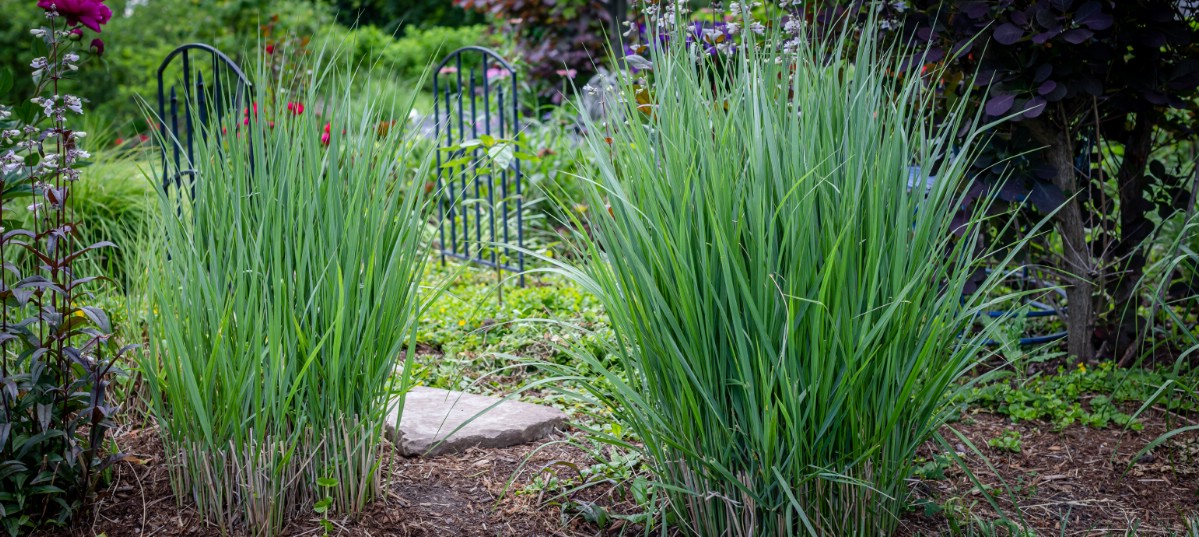
- Botanical name: Panicum virgatum
- Mature height: 5 feet
- Growing conditions: Partial to full sun, well-drained soil
- Ideal growing zones: 4-9
- Perennial Plant Association’s 2014 Perennial Plant of the Year!!
- Northwind switchgrass is very easy to grow and will enhance any sunny border.
- 4'-5' Height, 2'-3' Spread
- Switchgrass (Panicum virgatum) is a summer perennial grass that is native to North America. It is a natural component of the native tall-grass prairie which covered most of the Great Plains, as well...
- This native grass grows best in areas that receive 30 inches of rainfall a year or in irrigated areas with average to wet soils.
- It usually grows 3 to 5 feet in height and is often grown as an ornamental grass plant. It is excellent material for fresh and dried arrangements.
Next on our list is Switch Grass, also spelled “Switchgrass.” Sometimes, it is also known as tall panic grass, blackbent, Wobsqua grass, wild redtop, tall prairiegrass, Virginia switchgrass, and thatchgrass. This perennial plant can be found throughout the United States and Mexico as well as southern parts of Canada.
Tolerating a wide range of growing conditions (including floods, droughts, and soil in poor condition), this grass is a good choice for beginners. It does spread, but not aggressively, making it easy to control. If you prefer, you can try growing it in a planter (it will need to be a big one).
As a point of interest, switchgrass may be used as a source of energy. Oklahoma State University explains, “After extensive evaluations of many plant species in multiple locations, switchgrass was selected in 1991 by the U.S. Department of Energy as a model herbaceous energy crop for the development of a renewable feedstock source to produce transportation fuel. While switchgrass has been promoted as a ‘savior’ or the ‘answer to expensive, imported fuel,’ much work remains.”
At its tallest, this grass can reach up to 6 feet, so it can actually be an effective privacy screen. Its flowers are purple and feathery, and in the fall, the green grass turns golden. It can make for a dramatic addition to your yard, offering a wild prairie feel you will enjoy throughout the year.
5. Japanese Forest Grass
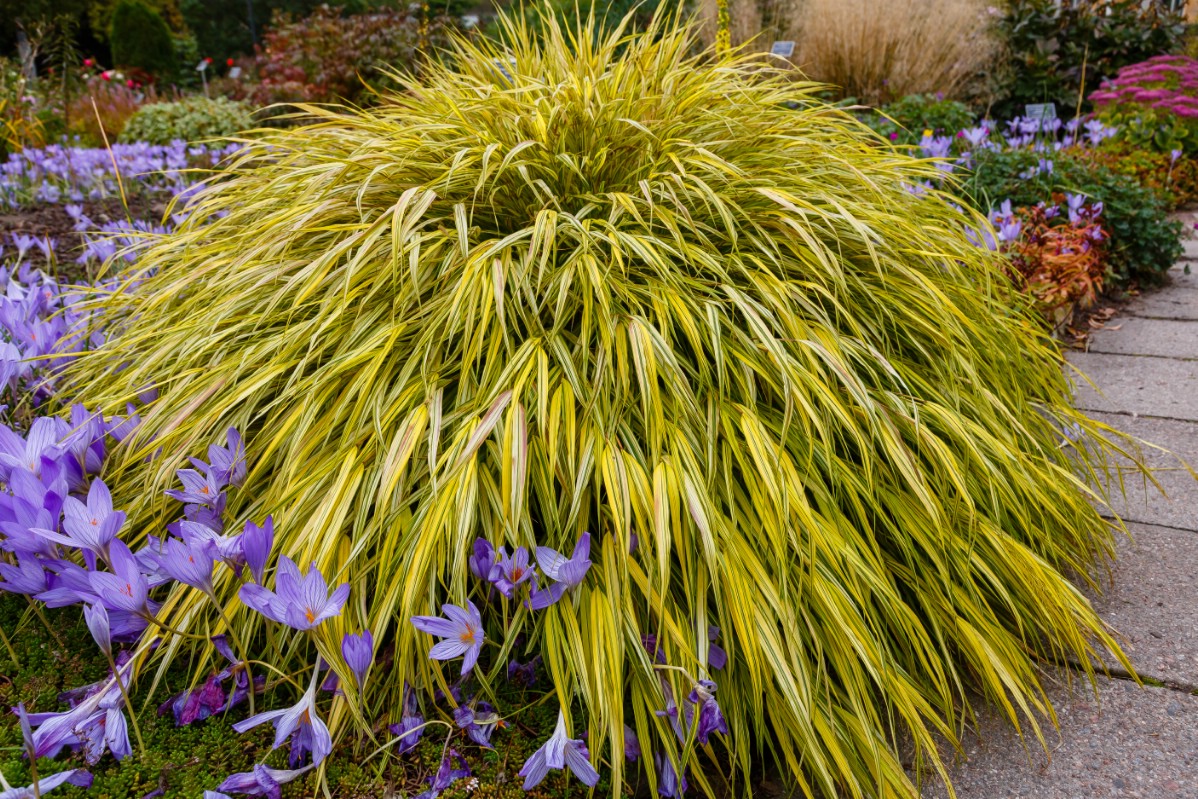
- Botanical name: Hakonechloa macra 'Aureola'
- Mature height: 1-2 feet
- Growing conditions: Partial sun, well-drained soil
- Ideal growing zones: 5-9
- PLEASE DO NOT ORDER IF YOU LIVE IN ONE OF THESE USDA RESTRICTED STATES: AK, AZ, CA, CO, ID, MT, NV, OR, UT, WA AND HI. Hardy in USDA zones 5-9.
- Part shade, full shade
- Long sword shaped golden leaves form graceful clumps growing about 12” in Height. Provides dramatic textural contrasts, especially when planted in drifts. Prefers moist, humus, well-drained soil....
If you are looking for a short grass that makes a good lining for walkways, one plant to think about is Japanese Forest Grass, also called Hakonechloa or “Hakone.”
This type of bunchgrass does well in partial shade, making it an option worth considering if you are having trouble getting sun-loving grasses to grow in a shady spot in your yard.
The leaves are bright green with a striped pattern, and during the summer, modest rust-colored flowers add visual interest. The leaves remind some people of those on bamboo. Usually, this grass doesn’t exceed a foot or so in height, but sometimes it can get to be up to 2 feet tall.
As far as timing goes, this is a flexible plant, because you can plant it in either the spring or autumn. It is resistant to pests and not prone to disease, requiring little in the way of maintenance throughout the year.
Although Japanese Forest Grass is relatively hardy, it does best in temperate climates and can die in extreme conditions. Also, while you can get away with growing it in a dry area, you’ll need to water it a lot and mulch it appropriately. It will be easiest to grow if you have a cool, shady, humid spot to plant it.
6. Sunset Glow Bamboo
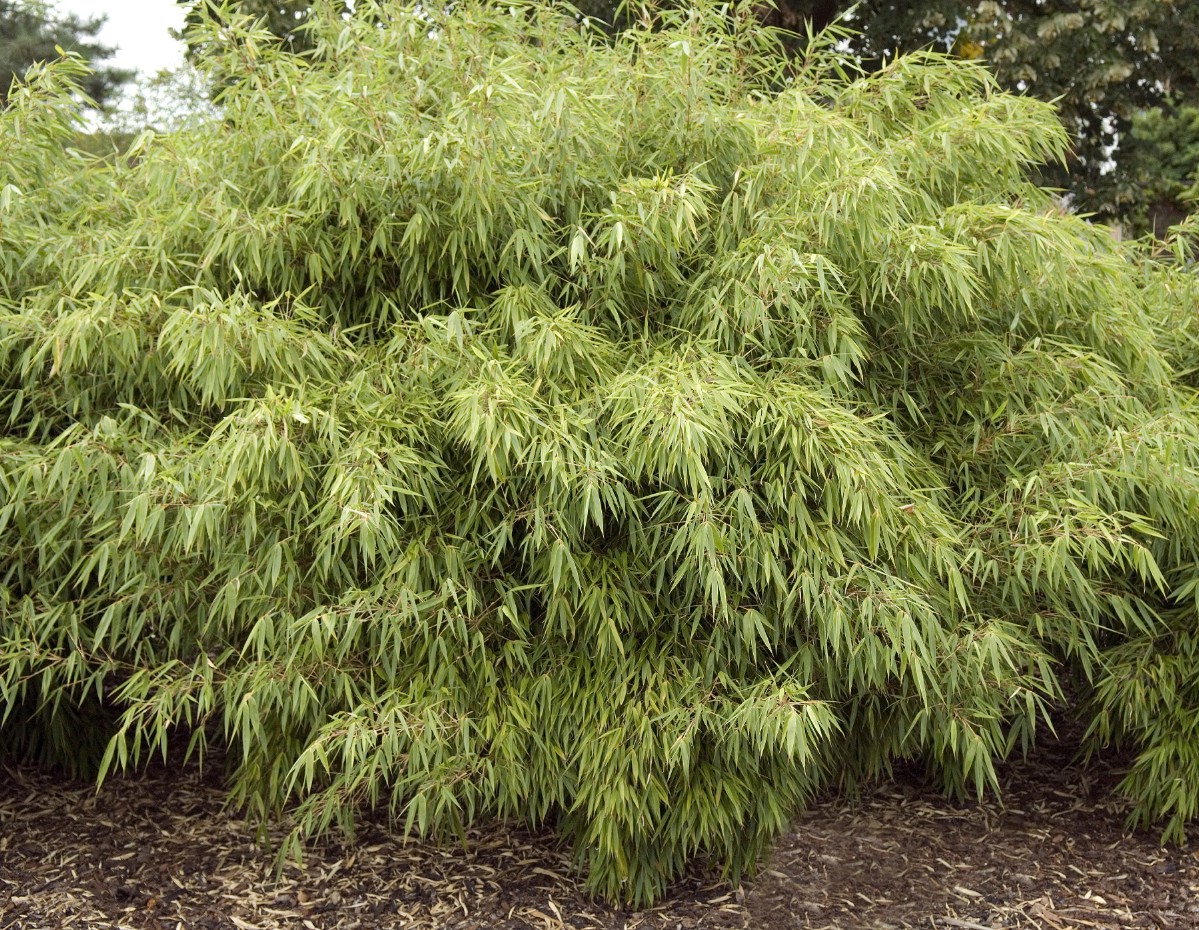
- Botanical name: Fargesia rufa
- Mature height: 6-8 feet
- Growing conditions: Partial to full sun
- Ideal growing zones: 5-9
- Extremely hardy to -10º f to -20º f. Takes full sun.
- Vigorous, rapid growth up to 8' tall when mature. Purple red sheaths on new culms.
- Dense, slightly weeping habit, makes a nice border or addition to a perennial bed.
- Extremely hardy to -10º f to -20º f. Takes full sun.
- Vigorous, rapid growth up to 8' tall when mature. Purple red sheaths on new culms.
- Dense, slightly weeping habit, makes a nice border or addition to a perennial bed.
A lot of people think that bamboo is a tree, which is why we sometimes discuss it in posts where we are talking about trees. But bamboo is classified as a grass, so this is the perfect place to share some bamboo ideas with you for your garden.
One type of bamboo you may want to think about planting is Sunset Glow Bamboo. This type of bamboo clumps rather than spreads. It grows quickly and can get to be quite tall (up to 8 feet), but it is neither aggressive nor invasive.
Another reason to think about growing Sunset Glow Bamboo as an ornamental grass is to take advantage of its hardiness. It can handle pretty much any conditions you can throw at it, whether that is extreme heat and sun or bitter cold. It also can survive a drought. Moreover, it will continue to look great even when it gets really dry.
The stems of this plant are an orangey color, which is why it has the name “Sunset Glow.” But the leaves are green, so the contrast is vivid.
7. Blue Oat Grass
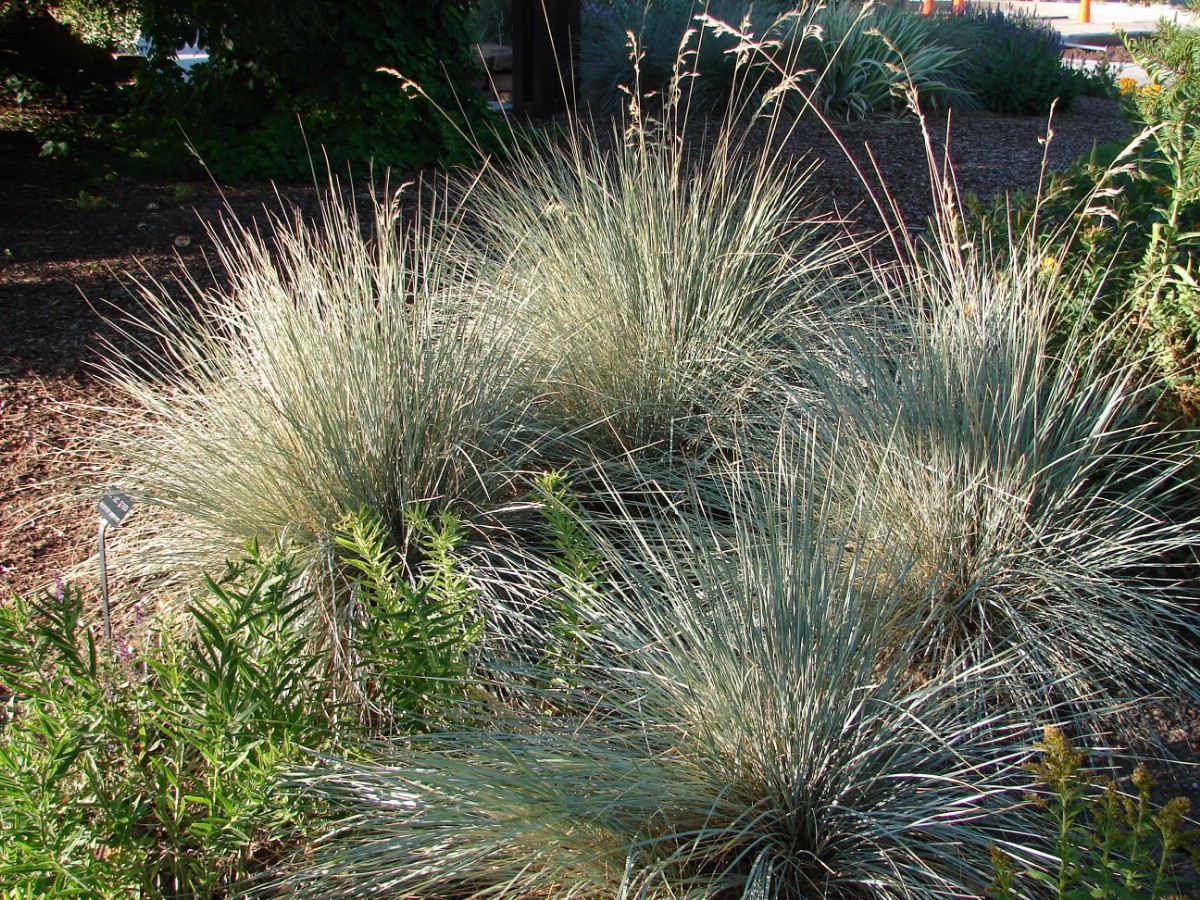
- Botanical name: Helictotrichon sempervirens
- Mature height: 4 feet
- Growing conditions: Full sun, well-drained soil
- Ideal growing zones: 4-9
- Brand:Sisyrinchium bellum, Country Of Manufacture:United States
- Model:Blue eyed Grass
- Mpn:Ornamental Grass
Not a lot of plants sport a bluish-green hue, but Blue Oat Grass is among the few that do. It forms in clumps and is easy to control. Clusters of beige stalks known as “panicles” emerge during summertime, which in turn produce “spikelets” of flowers with a blue-green color to complement the leaves.
As summer draws to a close, the spikelets lose their blue-green hue and take on a brownish color instead. Their resemblance to oats during the fall is what gives this plant the name “Blue Oat Grass.”
If your winter conditions are not harsh, Blue Oat Grass may retain its blue-green hue year-round, adding some welcome color to your yard.
And did we mention that Blue Oat Grass is pretty easy to grow? It is relatively resistant to disease and pests, and can survive even in low-quality, polluted soil. So, if you live in a city or suburb, it can be a good option.
The only time we would recommend steering clear of Blue Oat Grass is if your climate is especially humid or your soil is particularly damp. Blue Oat Grass can struggle in these types of conditions.
Indeed, because this type of ornamental grass thrives in drier climates and brings a soothing, cool blue tone to landscapes, it is a popular choice in desert regions.
8. Adagio Maiden Grass
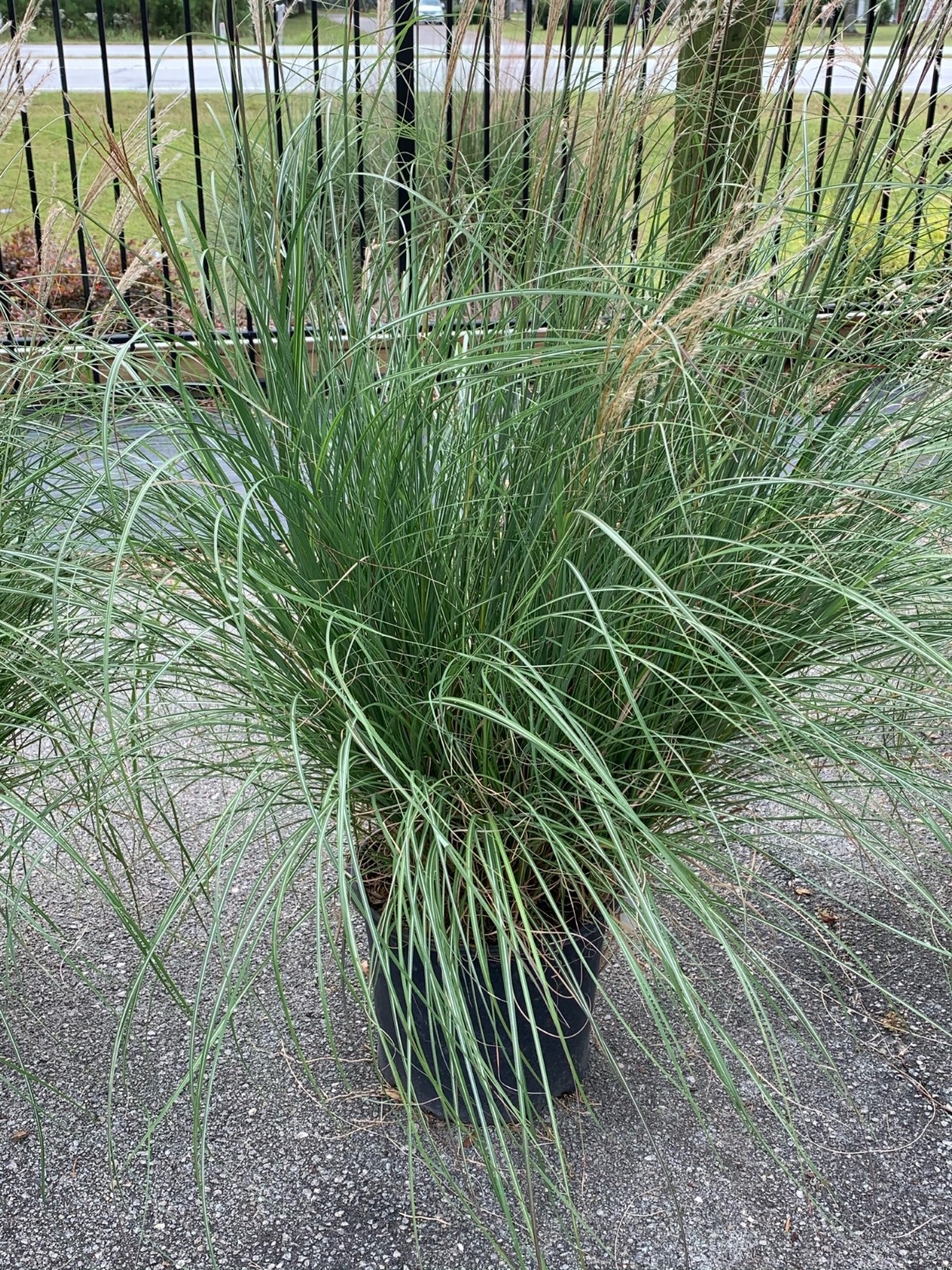
- Botanical name: Miscanthus sinensis 'Adagio'
- Mature height: 5 feet
- Growing conditions: Partial to full sun, tolerates sandy soil
- Ideal growing zones: 5-9
- This item is unavailable in HI and AK - Ships in a pot with soil
- USDA Zones: 5-9 - Mature Size: 3' H x 4' W
- Miscanthus sinensis 'Adagio'
- Numerous clusters of blossoms rise above the leaves, displaying a beautiful mix of bronze-pink hues that gradually transition to white. This diminutive botanical specimen showcases elegant,...
- The amount of sunlight required for optimal growth is partial to full sun. It thrives with regular watering, ideally on a weekly basis, or more frequently during periods of intense heat. This plant...
- To ensure the development of a robust and extensive root system, it is advisable to adhere to a consistent watering routine throughout the initial growth season. Trimming back and applying a...
This ornamental grass also sometimes is called “Miscanthus Adagio.” It forms in clumps, is easy to grow and maintain, and tolerates diverse conditions. Oh, and did we mention that deer don’t like eating this grass?
If you want it to function as a privacy screen, it can, because it can reach up to 5 feet in height.
Nevertheless, many people like to trim this ornamental grass regularly, because doing so in the winter can result in the plant producing leaves with an appealing silvery color. But the most dazzling feature of this plant is the yellowish-purplish plumes it produces during the summer.
The beauty of the plant does not fade as the weather gets cold—it simply transforms. The plant loses its green color and turns coppery, but the plumes remain.
9. Black Bamboo
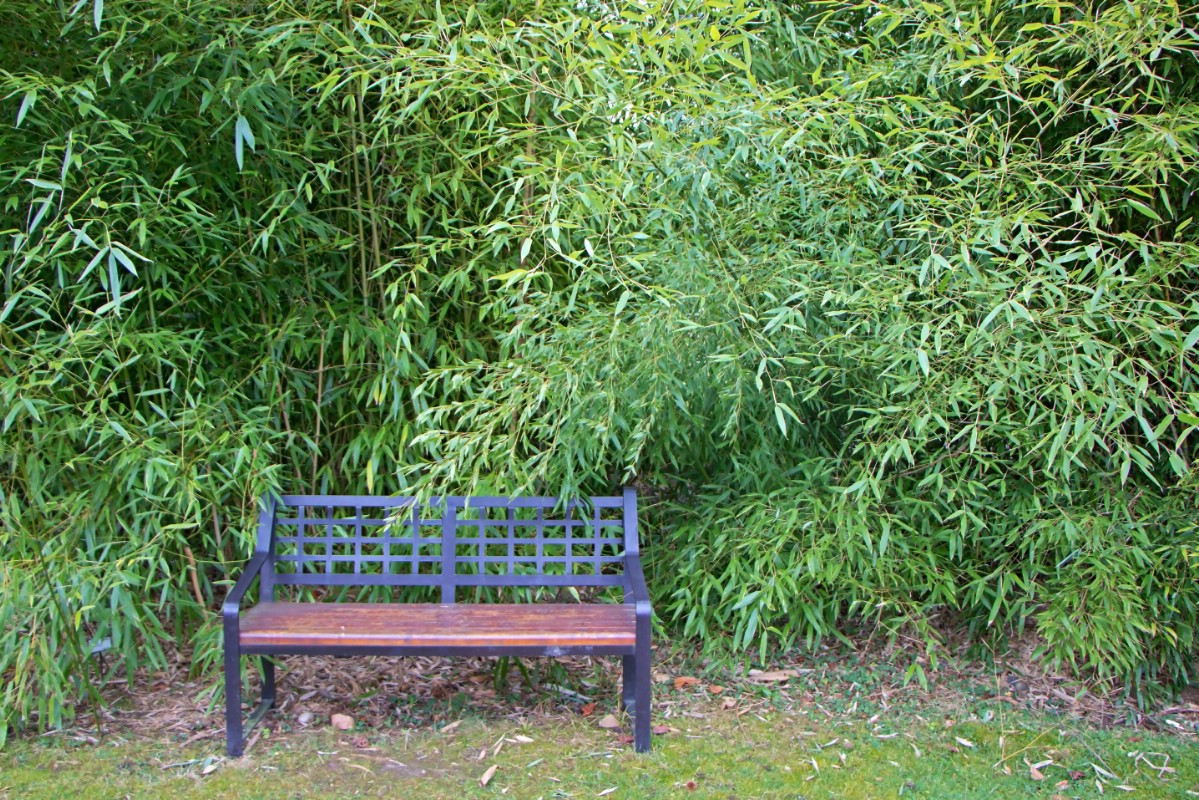
- Botanical name: Phyllostachys nigra
- Mature height: 15-25 feet
- Growing conditions: Partial to full
- Ideal growing zones: 6-10
- 300+ Seeds of the rare and exotic Black Bamboo to Plant and Grow
- The fastest growing Bamboo, get privacy or windbreak fast!
- Bamboo is a garden or and outdoor favorite for its unique look and fast growing traits!
- Jet Black Canes for a Dramatic Display - Mature height to 30 feet and cane diameter to 2 inches. Trade gallon size (#1)
- Cold hardy down to 5 degrees - Zone 7 to 11
- Usage - Specimen planting, hedge, screen, container, gorgeous just about anywhere
Let’s check out another ornamental grass in the bamboo category that can make for an incredible privacy screen. Black Bamboo can grow to reach up to 25 feet in height!
Just as Sunset Glow Bamboo takes its name from its reddish stalks, Black Bamboo’s name is a reference to its dark green stalks that are nearly black. The leaves are bright green, so the stalks contrast with them beautifully.
This bamboo grows rapidly and requires almost no maintenance, so just about anyone should be able to grow it successfully.
Another reason to think about growing Black Bamboo in your yard is if you are in a region where temperatures dip down way below freezing. This plant can survive even at 0 degrees Fahrenheit. So, if other types of bamboo are not making it through the winter where you live, this type might.
10. Purple Millet
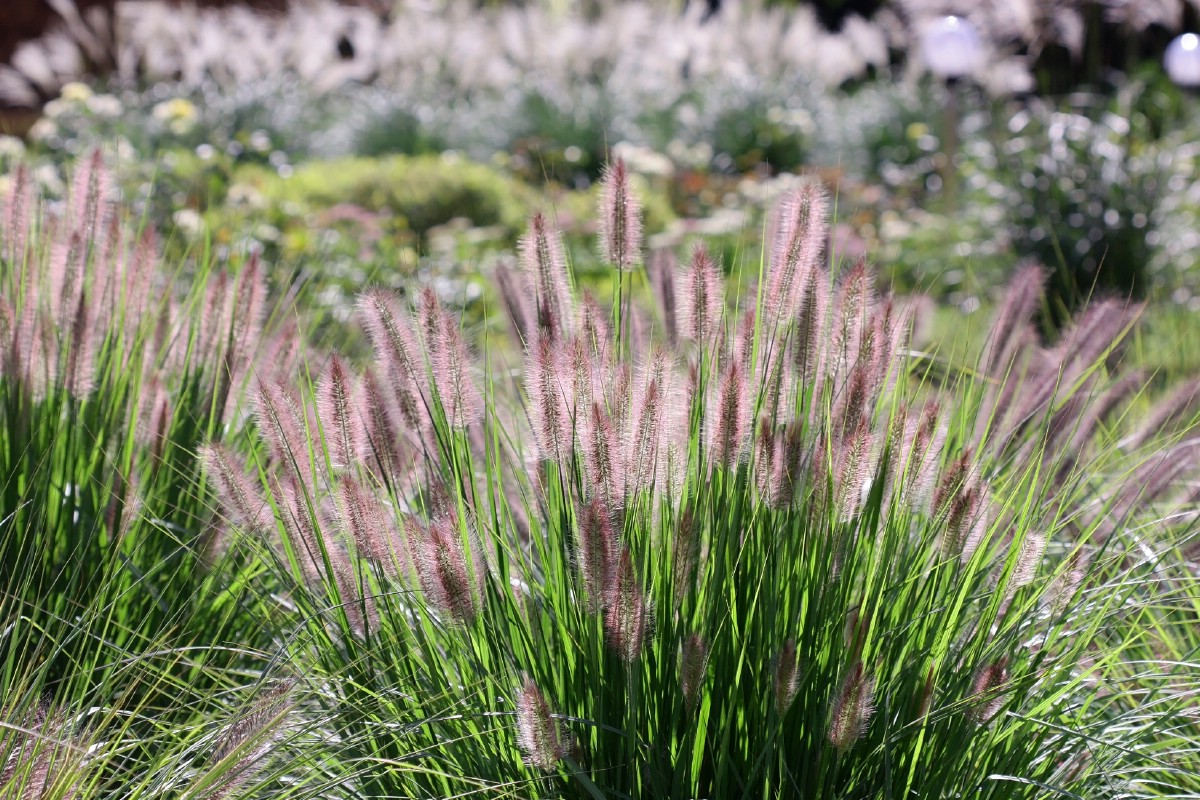
- Botanical name: Pennisetum glaucum
- Mature height: 5 feet
- Growing conditions: Partial to full sun, well-drained soil
- Ideal growing zones: 10-11
Purple Millet is an ornamental grass that is also known as “Purple Majesty” or “Purple Baron.” While most of the grasses we have shared in this list are perennials, this one is an annual (at least, that is the way it is usually grown). It grows rapidly enough, however, that it can get to be up to 5 feet tall. If you live in a dry climate, you should find that this plant weathers droughts admirably.
The appearance of Purple Millet is similar to cattails. Initially, the leaves are green, but during summer, they will shift toward mahogany. The bottlebrush spikes that the plant produces are golden to start, but then turn purple as they produce seeds come autumn.
While you can remove the Purple Millet after it dries up in winter, some people recommend that you don’t. If you have a cold enough climate, Purple Millet may look attractive with ice on it.
11. Gulf Stream Heavenly Bamboo
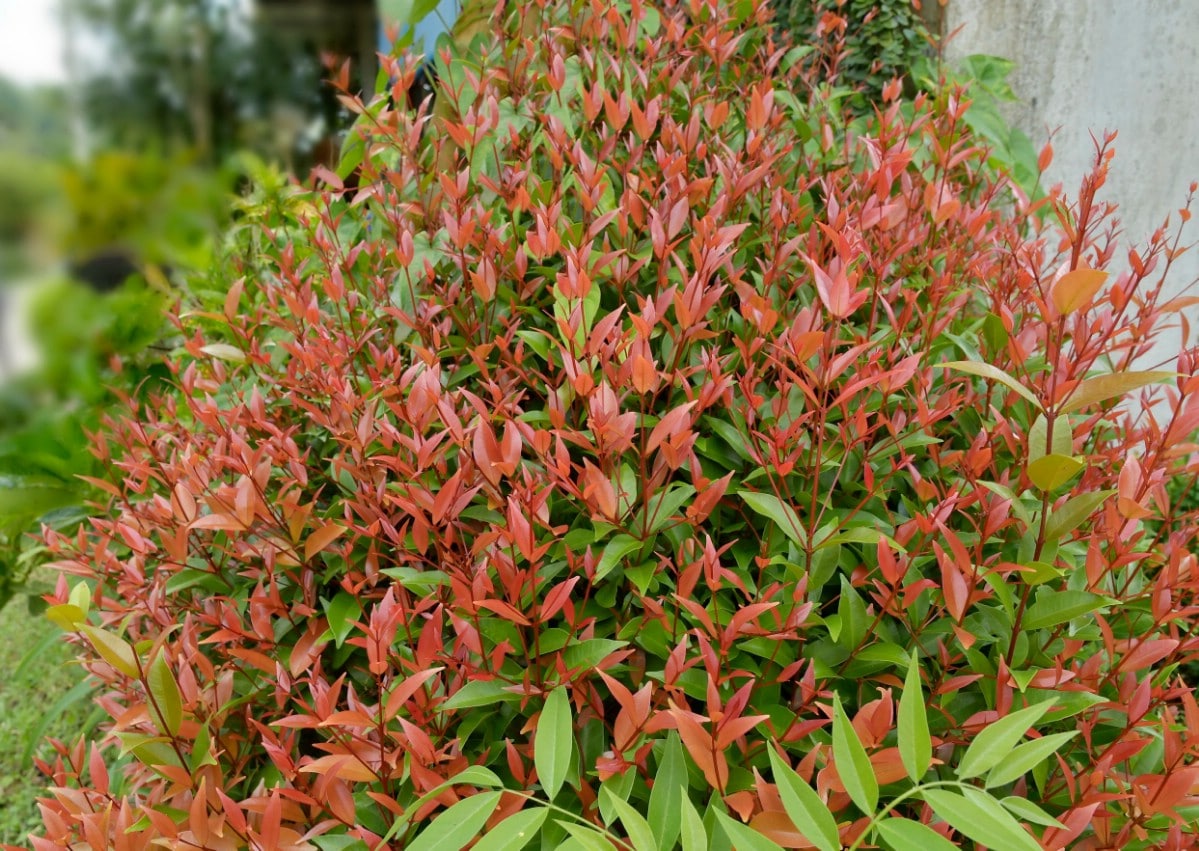
- Botanical name: Nandina domestica 'Gulf Stream'
- Mature height: 3-3.5 feet
- Growing conditions: Partial to full
- Ideal growing zones: 6-10
- Grown, packaged and shipped exclusively by Florida Foliage. A very hardy, trouble-free and colorful evergreen shrub with vibrant, ever-changing foliage. New leaves emerge scarlet red in spring and...
- Easily grown in average, well-drained soil. Water deeply, regularly during first growing season to establish extensive root system. Once established, reduce frequency; tolerates mild drought. Apply...
- For a pleasant medium-sized addition to your landscaping setup, go with the Gulf Stream Nandina. This bush is known as being very hardy, as it can survive long stretches without being watered....
- The firepower nandina is a vibrant, colorful low growing shrub that does not produce fruit, unlike other nandina varieties
- this unique nandina variety boast vibrant green new growth that changes to bright red and blush pink foliage during the fall and winter
- The firepower stays compact at 30in. tall and wide at full maturity, and has a round/mounded growth habit
One type of bamboo that can provide interest in your yard throughout the year is Gulf Stream Heavenly Bamboo.
During springtime, many plants are green, but this one will stand out from the others in your yard, as the leaves will be deep red. But as the season progresses into summer, the leaves will turn bluish green. You’ll also be able to delight in white flowers at this time of year.
When summer turns to fall, the leaves will once again be red. In winter, they will not fade, but rather take on orangey hues.
12. Cord Grass
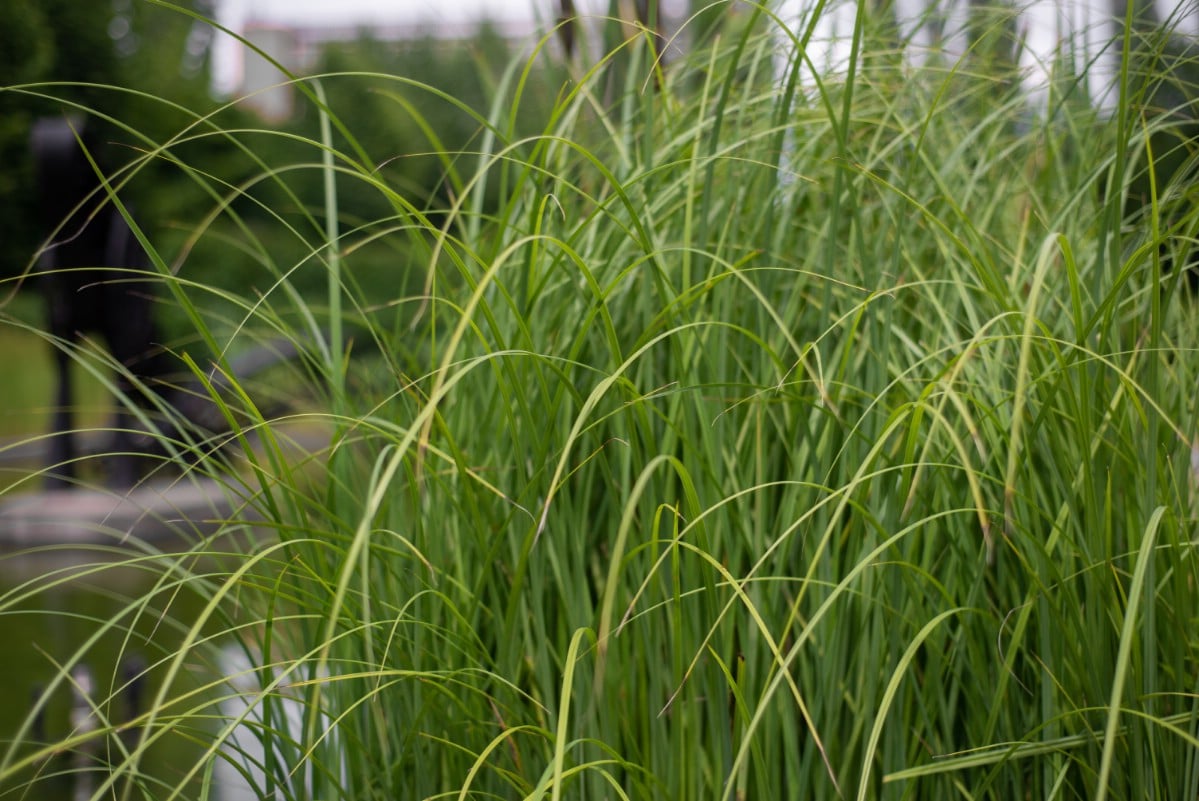
- Botanical name: Spartina pectinata
- Mature height: 7 feet
- Growing conditions: Full sun, moist soil
- Ideal growing zones: 4-7
Spartina pectinata is a type of cord grass (also spelled “cordgrass”) that is popular to grow as an ornamental grass. Specifically, it goes by the name “prairie cordgrass,” and may also be known as “tall marshgrass,” “freshwater cordgrass,” or “sloughgrass.”
You can find it growing throughout much of the US and Canada, as well as parts of Mexico. But if you are in the southeast or southwest USA, you may not be familiar with it.
As you might guess given some of its names, this plant typically is native to wetlands. That means that if you have moist soil, that may be ideal for growing cordgrass. But keep in mind that it does not do well in flood conditions. It can help to combat soil erosion, however.
So, if you have a water feature in your landscape such as a pond, planting cordgrass along the banks may make sense. The grass should thrive there, and might also help to prevent erosion of your soil.
Since cordgrass can grow as tall as 7 feet, it can work well as a privacy screen.
As for its appearance, cord grass features green leaves and sends up tan stalks with feathery ends.
13. Lemon Grass Plant
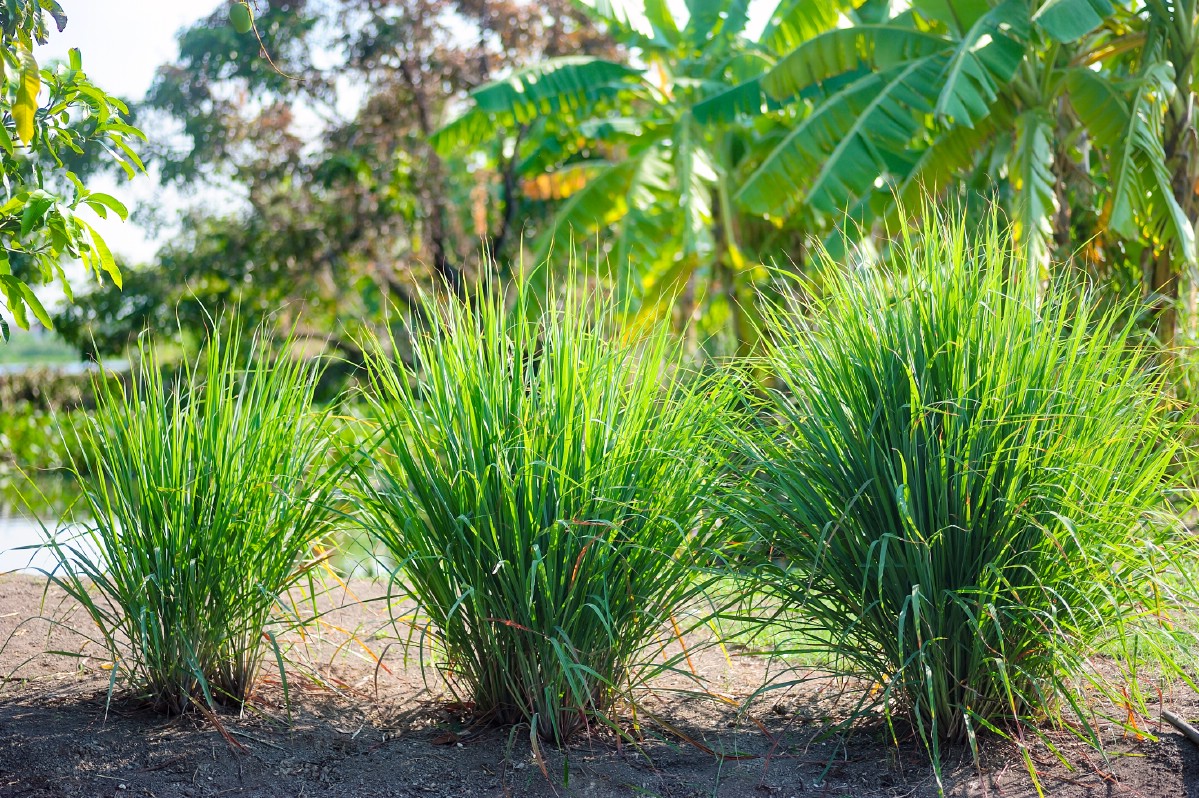
- Botanical name: Cymbopogon citratus
- Mature height: 3-4 feet
- Growing conditions: Full sun
- Ideal growing zones: 9-11
- Fast-growing and low-maintenance lemongrass plant, perfect for both beginners and expert gardeners.
- These citronella plants for outside are natural mosquito repellents—ideal for planting around walkways, decks, and patios.
- A lemon grass live plant spacing can be adjusted according to your aesthetic preference, with each stalk multiplying over time.
- Our Large Lemongrass Plant is thriving inside a 4" premium nursery pot. Each plant will have several main stalks with a thriving root system that fills in the entire pot!
- West Indian Lemongrass is packed with essential lemongrass and citronella oil. Lemongrass is loved for its nutrient-dense properties, making its way into feel-good medicines, flavorsome foods, and...
- We have a healthy plant guarantee. We carefully prepare and package our plants. This helps ensure they survive the journey to their new home and thrive when they arrive. If for any reason you don't...
Do you get a lot of unwanted insects buzzing around in your backyard? If you want a plant that is not only pest-resistant but can actually help deter insects, you should consider planting lemon grass, also spelled “lemongrass.” Some nicknames for this grass include citronella grass, fever grass, silky heads, oily heads, barbed wire grass, Malabar grass, and Cochin grass.
This particular species of lemon grass smells and tastes delicious. As you would expect given its name, the flavour can be described as lemony.
If you grow it in your yard, you may notice a decrease in pesky insects flitting around, and you will enjoy the plant’s invigorating aroma.
You can harvest some of it to use in your recipes. It is rich in vitamins and minerals, and goes well in soups and stir-fry recipes.
With its bright green leaves, it can add some visual appeal to your yard as well. And since it is a perennial, you can enjoy its many benefits over years to come.
14. Fiber Optic Grass
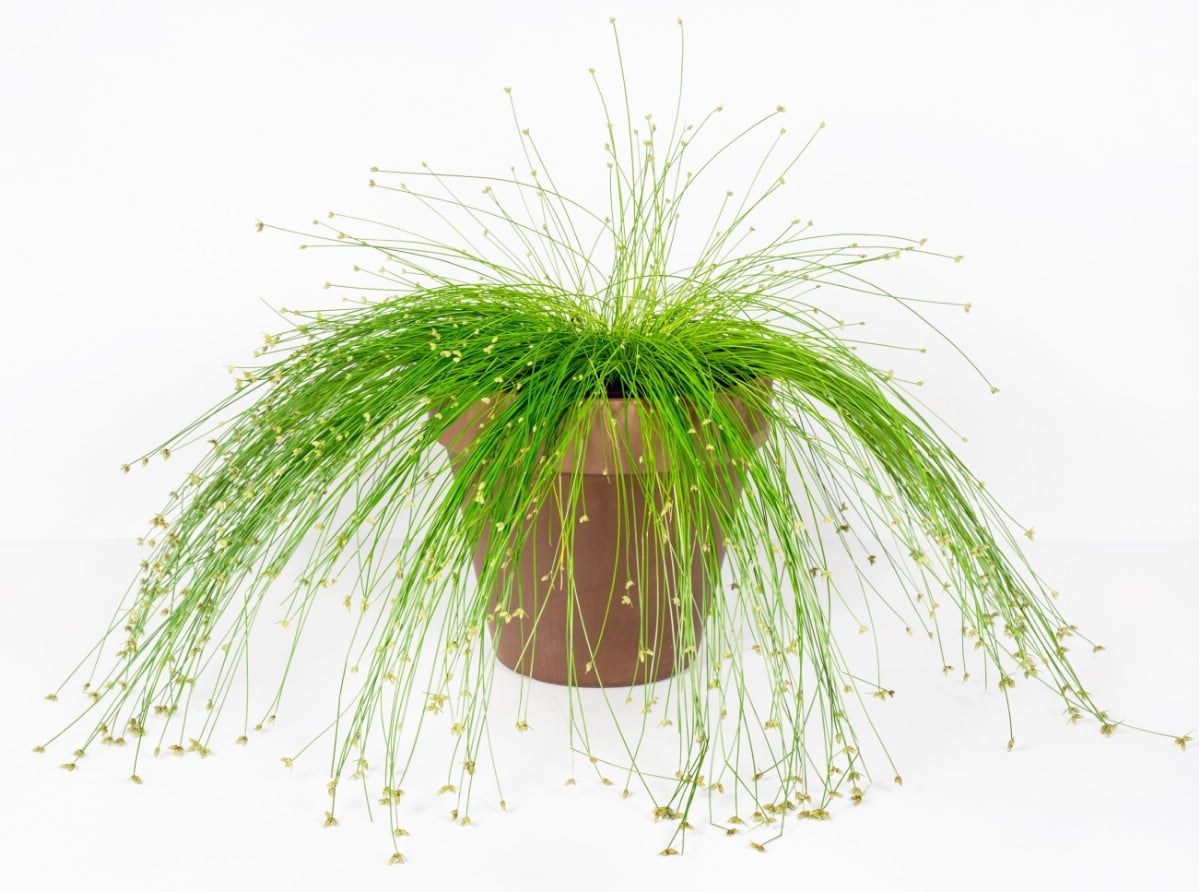
- Botanical name: Isolepis cernua
- Mature height: 6 inches
- Growing conditions: Partial to full sun, moist soil
- Ideal growing zones: 10-11
- Member of Houseplants
- Requires partial sun - sun
- Dimensions: 12.00in high, 2.00in high on delivery, spreads 20.00in
If you are in search of a real attention-grabber for your yard, the visually striking Isolepis cernua, commonly known as “Fiber Optic Grass,” is worth considering. Some other names it goes by include slender club-rush, low bulrush, and tufted clubrush.
While Fiber Optic Grass grows throughout the world, it is most commonly encountered in wetlands and coastal regions.
Technically, it is an evergreen sedge, not a true grass. Nevertheless, it is often marketed as an ornamental grass since it looks like one.
At some point, you have probably encountered a fiber optic lamp featuring numerous strands that are bright at the tips. This plant looks like a natural version of that. Of course, it doesn’t glow, but the little white flowers at the tips of the green stems give it a similar appearance. The illusion is particularly convincing if you are standing some distance away from the plant.
This effect is prominent during the summer. When autumn comes along, the stems tend to turn brown.
Because this is a wetlands plant, it will not thrive in dry conditions. So, you will have the best luck growing it if you have damp soil. You may need to water it frequently if your soil tends to dry out.
Do you have a pond in your backyard? You can actually grow Fiber Optic Grass directly in the water. Do not fully submerge the plant all at once, or it may die. It needs time to adjust.
One more awesome thing about Fiber Optic Grass is that it is resistant to deer. That means you can enjoy it without having to worry about spraying it or chasing unwanted guests away.
15. Northern Sea Oats
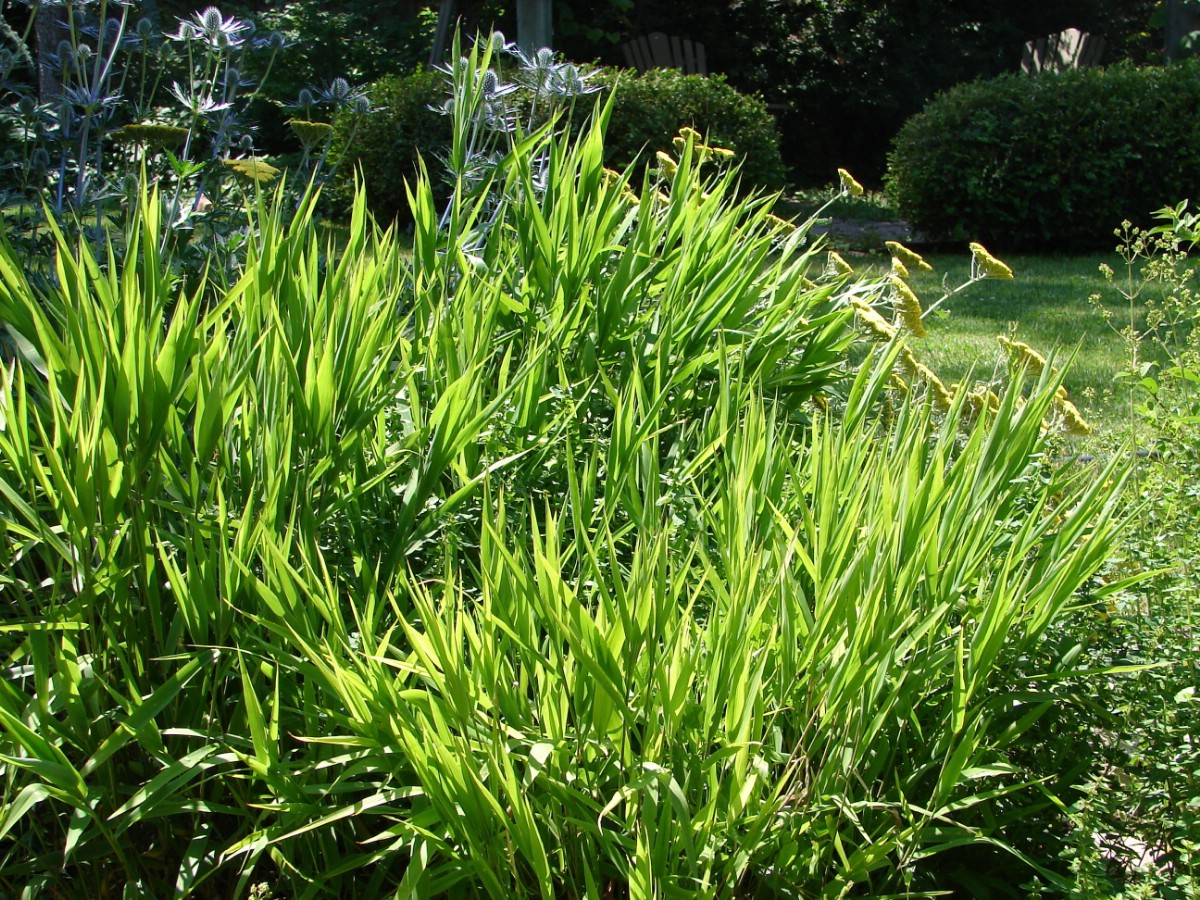
- Botanical name: Chasmanthium latifolium
- Mature height: 3 feet
- Growing conditions: Partial to full sun, well-drained soil
- Ideal growing zones: 5-9
- Chasmanthium Latifolium is a clump-forming, perennial grass that may grow up to 4'.
- Prized as an easy-care shade grass, northern sea oats is characterized by its large, delicate seedheads
- Frequently used to prevent soil erosion along waterways, the seed stalks are lovely in floral arrangements.
- NORTHERN SEA OATS GRASS Inland Chasmanthium jocad (100 Seeds)
- NAME: Northern Sea Oats | OTHER COMMON NAMES: River Oats / Inland Seaoats | SCIENTIFIC NAME: Chasmanthium Latifolium | COLOR: Green & reddish tan in the fall | PLANT SEEDS: Fall / Cold stratify 1...
- HARDINESS ZONE: 3 - 9 | PLANT HEIGHT: 24 - 36" | PLANT SPACING: 12 - 18" | LIGHT REQUIREMENTS: Sun - Part Shade | SOIL & WATER PREFERENCES: Average - Moist | QUANTITY: 100 Seeds
Chasmanthium latifolium, commonly known as Northern Sea Oats, is mostly found in the Midwest. You can find it in Pennsylvania and Michigan as well, but it is threatened in those states. This plant can also be referred to as “inland sea oats,” “woodoats,” or “river oats.”
While the ideal zones for growing Northern Sea Oats are 5-9, you may manage it in 3-4 as well. It does particularly well in loams, acidic sands, and clays.
A number of different types of caterpillars like eating Northern Sea Oats, so if you want to attract butterflies to your yard, planting this ornamental grass is one way to do it.
While a lot of grasses don’t like shade much, Northern Sea Oats do well in it. It is resistant to diseases and pests, and grows neatly in clumps.
Northern Sea Oats feature green leaves and thin, arching stems. Seed heads hang from the stems, starting out as green, but later turning bronze with a purplish tint. The leaves themselves lose their color during the winter.
Even though it might be hard to come by Northern Sea Oats in nature, they are not all that difficult to grow in your own yard with the right conditions.
16. Ravenna Grass
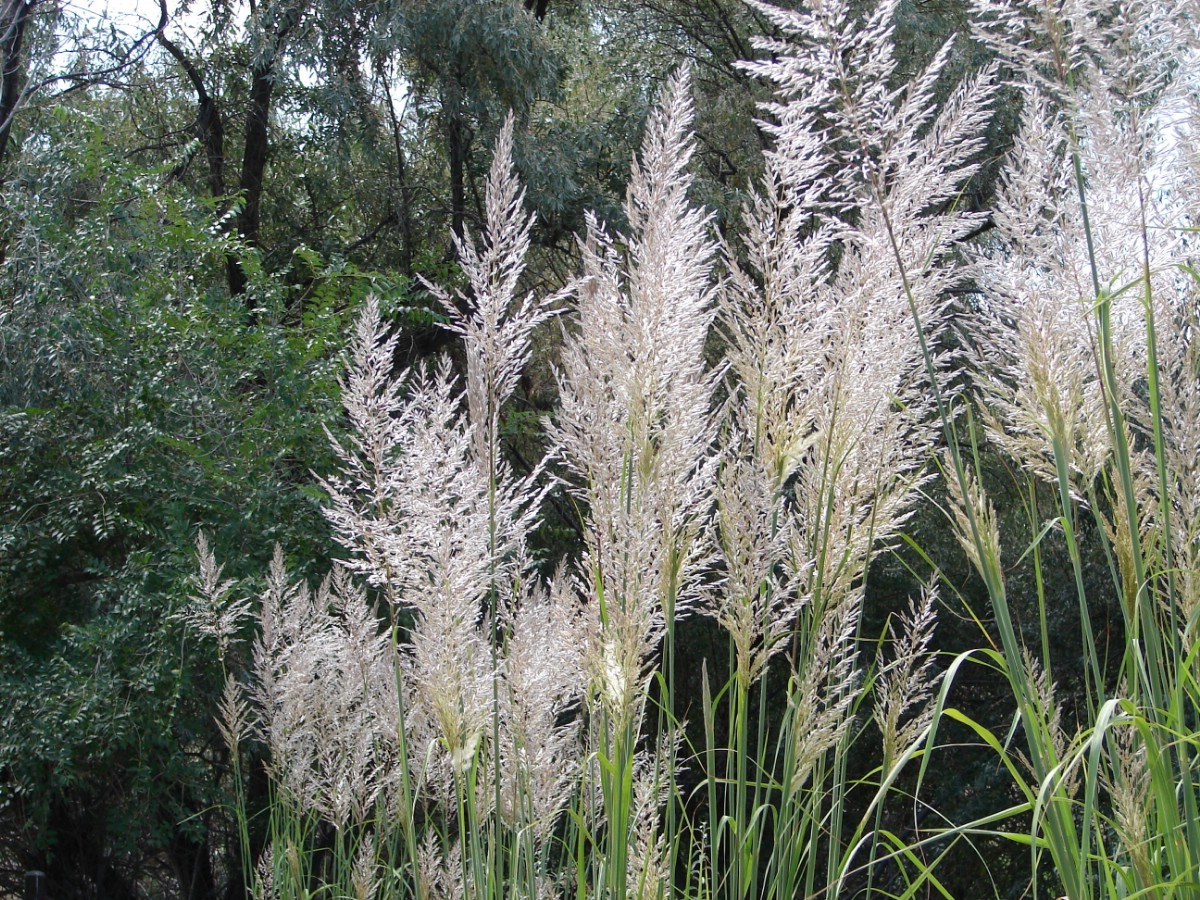
- Botanical name: Saccharum ravennae
- Mature height: 13 feet
- Growing conditions: Full sun, well-drained soil
- Ideal growing zones: 6-9
This plant is also called “elephant grass,” “hardy pampas grass,” “ekra,” or “ikora.” The name “Ravenna Grass” can be spelled as one or two words.
If you need to plant something to stabilize your soil, this grass might be a good choice, since it does a good job keeping soil from eroding.
It also can work well as a privacy screen as it produces very tall stems and large leaves. In fact, the leaves can grow to be up to a meter in length, and the stems may grow up to 13 feet tall. The plumes at the tops of the stems are large and feathery.
There are a couple of precautions to be aware of. For one thing, this plant is toxic to pets. For another, it spreads aggressively, and may overtake other plant beds. So, you may need to take extra pains to control it. Nevertheless, the effort can be worth it to enjoy the dramatic beauty it brings to your terrain.
17. Edible Bamboo Plant
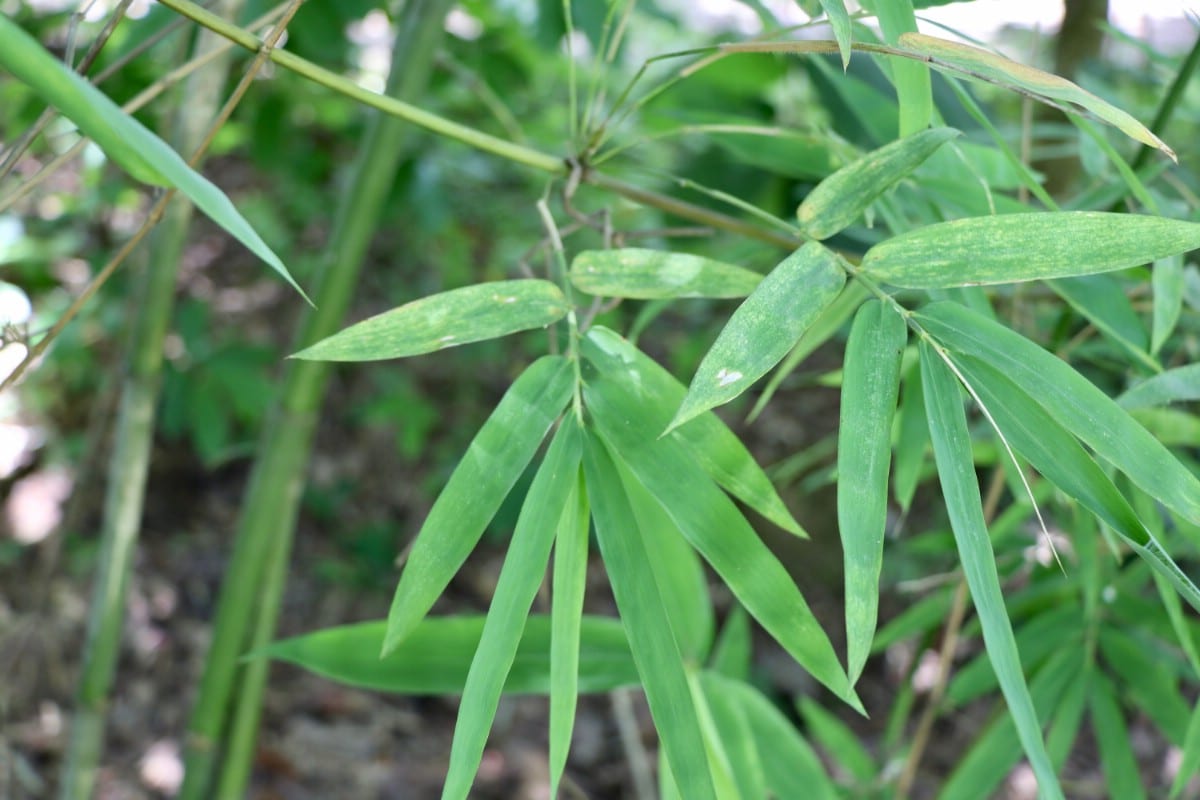
- Botanical name: Dendrocalamus strictus
- Mature height: 10-15 feet
- Growing conditions: Partial to full sun
- Ideal growing zones: 8-11 (or 4-11 if on the patio)
- HARDINESS ZONE.7-10
- GROW.Plant 3 to 4 moso bamboo seeds in each 2-inch pot.Use the water spray bottle.Sprinkle approximately ¾ of an inch of seed starting mix Use the water spray bottle to mist the surface of the...
- WHEN TO PLANT.Spring
- 50 Seeds of Giant Moso Bamboo is an excellent choice for anyone looking to add a touch of natural beauty to their home or garden. This organic plant bamboo seeds produce a perennial evergreen plant...
- The Giant Moso Bamboo is a fast-growing variety that is known for its impressive size, reaching up to 75 feet tall when mature. The plant produces large, lush green leaves that create a natural...
- One of the best things about this bamboo variety is its edible shoots, which are a delicious and nutritious addition to many dishes. As the plant matures, it will produce more shoots, providing you...
Another tall bamboo plant to consider as a privacy screen is Dendrocalamus strictus, which grows rapidly and can reach up to 15 feet in height. Not only that, but it is easy to grow since it can tolerate a wide range of climate conditions. About the only thing you need to worry about is harsh winds. It is not aggressive, so it won’t take over your lawn.
You can harvest this plant’s shoots to use in your recipes, which is why it is called “Edible Bamboo Plant.”
Indeed, it might work well in some of the same recipes as the Lemon Grass you might also have decided to grow!
18. Golden Bamboo
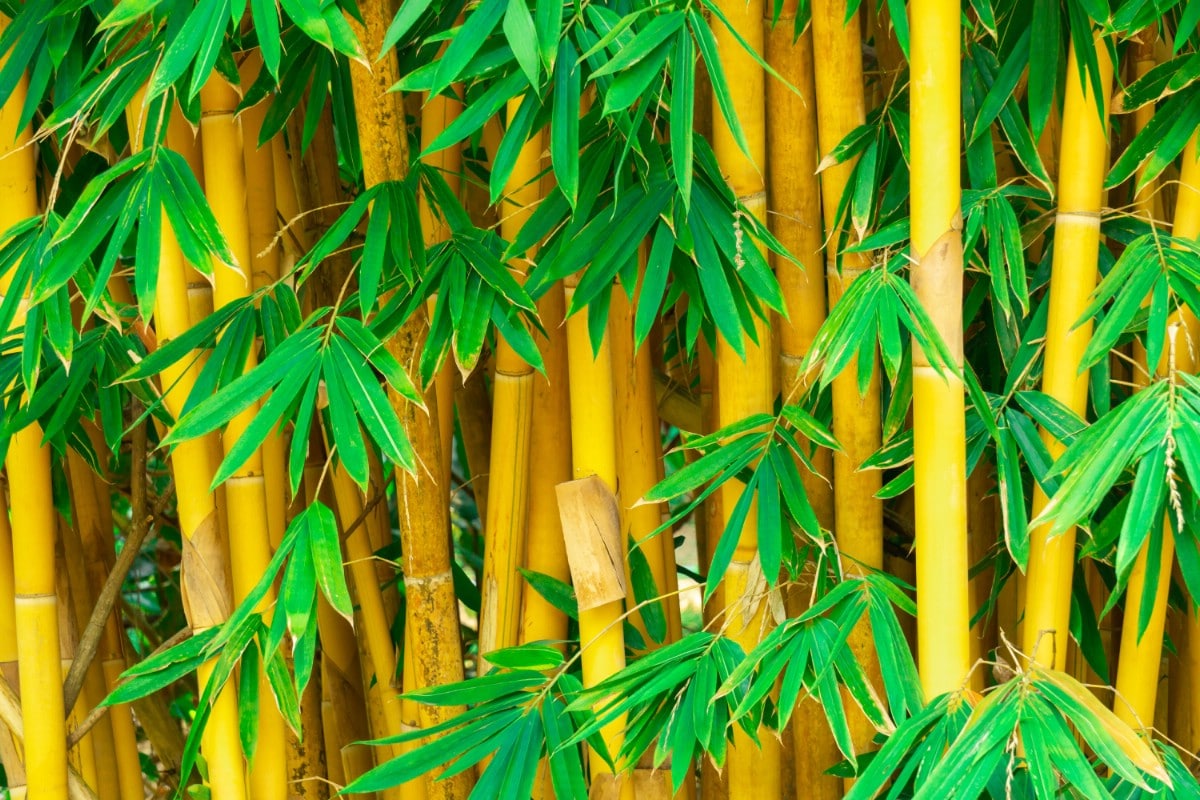
- Botanical name: Phyllostachys aurea
- Mature height: 30 feet
- Growing conditions: Partial to full sunlight
- Ideal growing zones: 6-10
Golden Bamboo is a plant that can do well through most of the US, and can grow to be even larger than Edible Bamboo Plant or Black Bamboo. It can achieve a maximum height of around 30 feet, and can grow as wide as 20 feet.
Golden Bamboo, like Edible Bamboo, tolerates a wide range of soil types and climates. But it too needs to be protected from harsh winds.
19. Zebra Grass
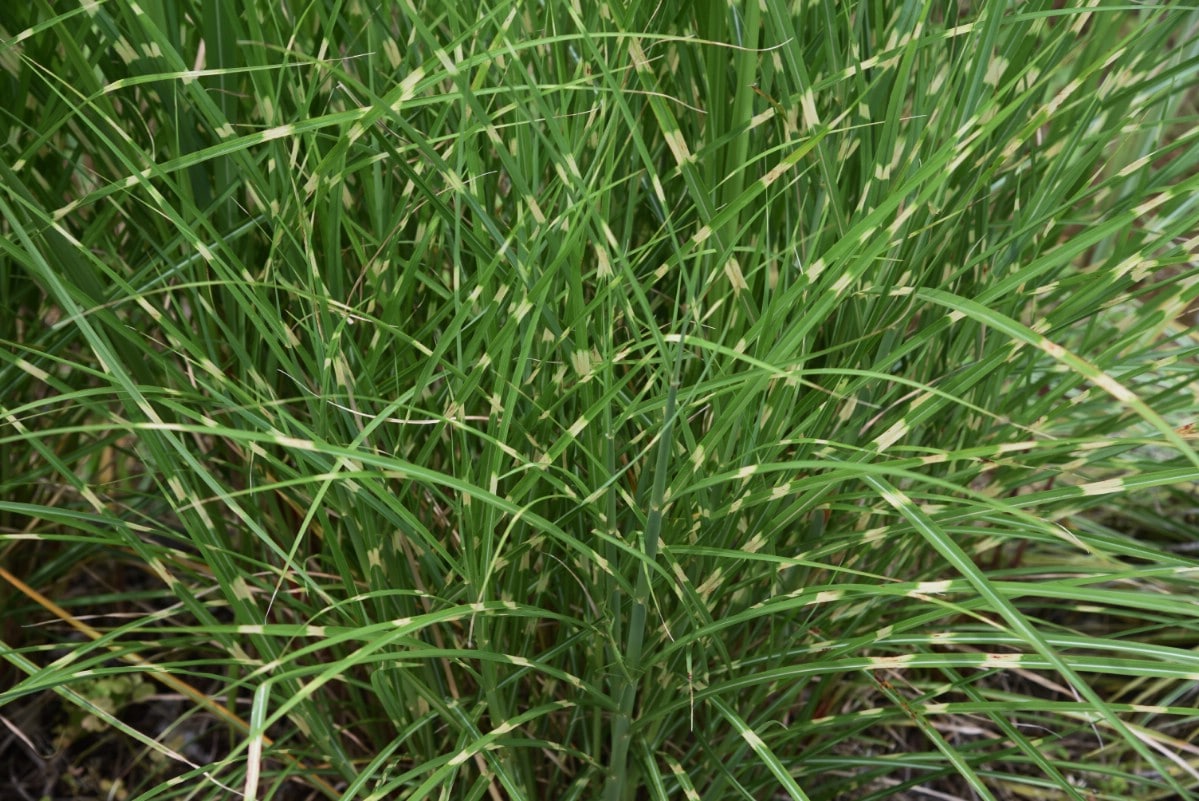
- Botanical name: Miscanthus sinensis 'Strictus'
- Mature height: 5 feet
- Growing conditions: Full sun, well-drained soil
- Ideal growing zones: 4-9
- Mature Height: 4-8 ft.
- Light Requirements: Full Sun, partial shade
- zones 4, 5 , 6 , 7 , 8 , 9
This ornamental grass is native to the Far East, and stands out the moment you see it thanks to its leaves, which feature green and tan horizontal stripes. The contrast in colors makes the stripes stand out even if you are at a distance from the plant.
During the summer, Zebra Grass produces white flowers, and in fall, attractive seed head plumes.
The striped effect does not last all year, since the green fades, so during the winter, the leaves are tan. Still, the overall form of the plant is graceful and remains beautiful year-round.
Although it is generally okay to plant Zebra Grass in the spring or autumn, if you live in an area with harsh winters, it is a better idea too plant during the springtime. Otherwise, the plant may struggle to get started.
Be aware that this plant does have a habit of spreading, so you may need to take care that it does not overtake your yard.
20. Mexican Feather Grass
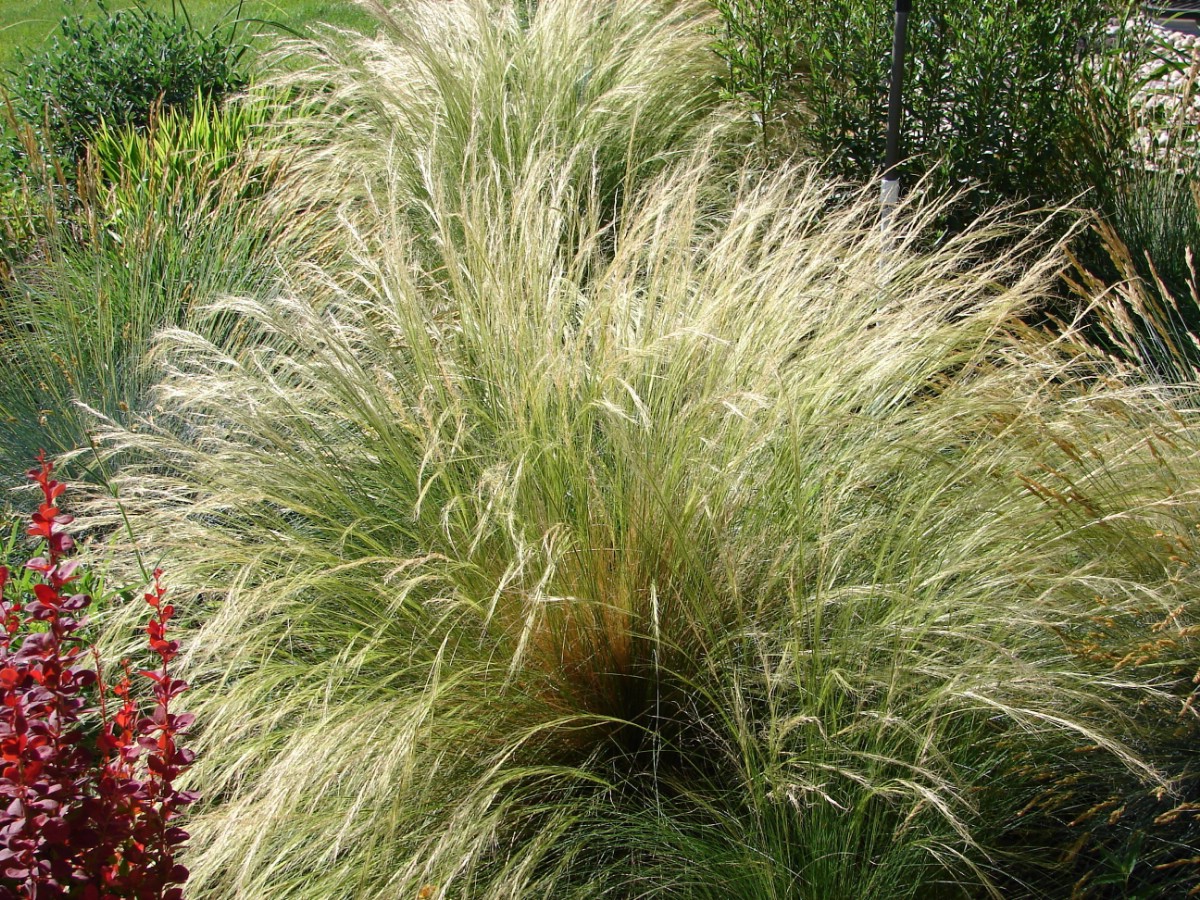
- Botanical name: Nassella tenuissima
- Mature height: 1-2 feet
- Growing conditions: Full sun, well-drained soil
- Ideal growing zones: 6-10
- Stipa tenuissima is commonly known as Mexican Feather Grass, and it a lovely perennial ornamental grass. It has a mounding habit with thin flexible leaves that form thick green clumps.
- Grow as a perennial ornamental grass in USDA zones 6 - 10. Reaches a low growing heifght of 16 inches with white plumes.
- The flowers usually appear in June and turn from green to gold as they mature. They work well planted in containers as well as directly in the garden. They are especially attractive at night with...
- Tends to spread by sprouting up around yard
- Plant in bulk for meadow look
- Viable option for hillsides
Are you looking for a grass that ripples beautifully as the wind sweeps through it? You may want to consider Mexican Feather Grass. Sometimes it is referred to as “Mexican needle grass,” “pony tails,” “silky thread grass,” or “Texas tussock.”
As the name implies, this plant is native to Mexico, Central and South America, and the southwestern US.
That means it thrives best if you live in the southern part of the US, but it also can do well along the coasts. It can stand up to drought conditions, and won’t be deterred by high heat. So, it is perfect for the desert. Indeed, it loves full sunlight, but if you have some shade, it should still grow well.
This hardy plant may occasionally develop leaf spot or aphids, but otherwise resists most pests and diseases. Deer will not find it appealing, nor will rabbits.
There is one potential drawback of Mexican Feather Grass, however, and that is that it can spread rapidly and aggressively, to the point where it is classified in some regions as invasive.
But on the bright side, you don’t need to water this grass much, so that reduces some of the maintenance involved.
21. Purple Moor Grass
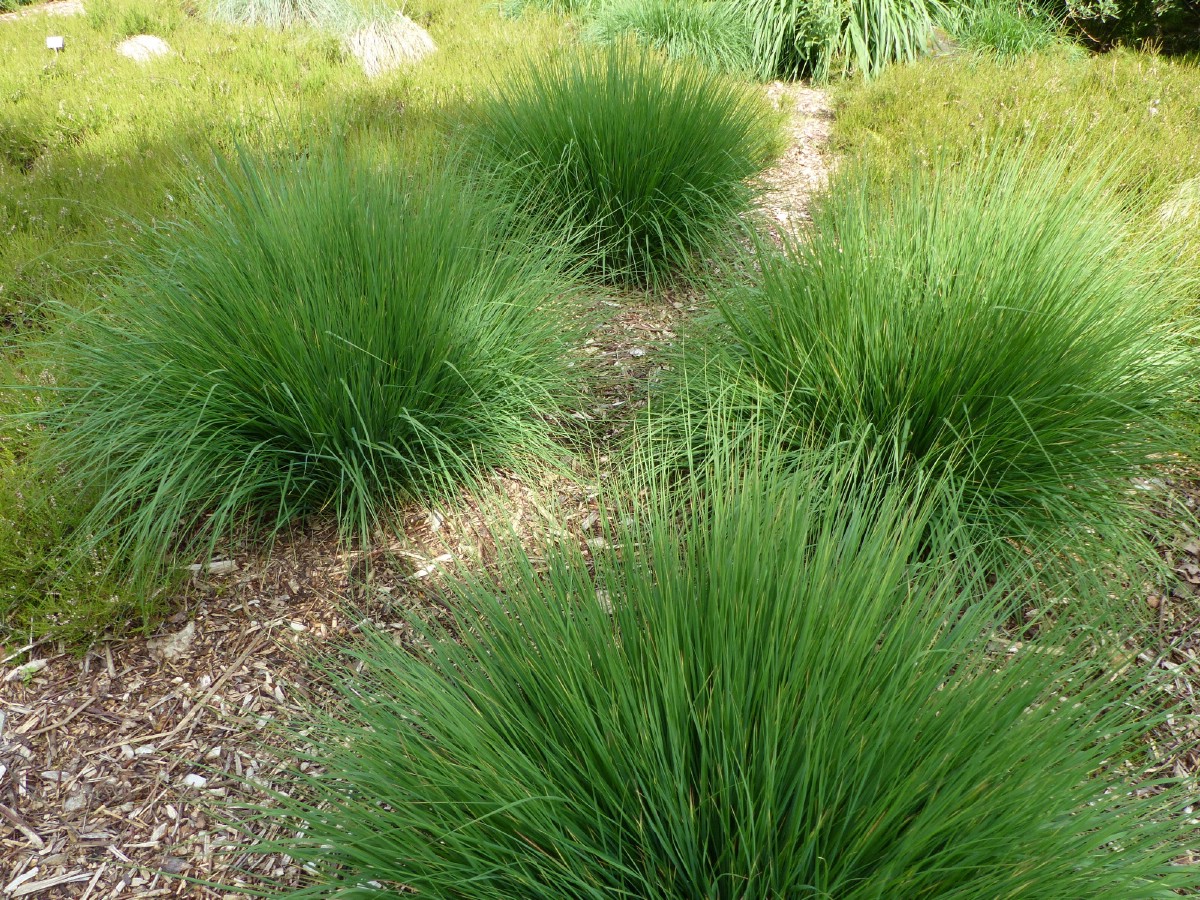
- Botanical name: Molinia caerulea
- Mature height: 5 feet
- Growing conditions: Partial to full sun, moist soil
- Ideal growing zones: 5-9
- Eragrostis spectabilis is commonly called Purple Love Grass. It is native to the United States both in the east and Midwest. It grows well on sandy infertile soils, and it prefers a location in full...
- Purple love grass grows as a perennial ornamental grass in USDA zones 5 - 10 reaching a height of 20 inches.
- It becomes are haze of rosy purple and dances in the summer breezes making an attractive addition to any landscape. In the fall the foliage turns to a bronze color.
Molinia caerulea is known as “Purple Moor Grass” or “Tall Purple Moor Grass.” Native to the lowlands of Europe, North Africa, and western Asia, it can do well in a wide range of soil conditions, but it prefers acidic soils. It thrives on moisture, which is why it can often be found in bogs.
The leaves of Purple Moor Grass are not purple, but green. The name refers to the spikelets, which are purple, and top the stems. The stems grow more or less straight upward, rather than arcing.
One nice thing about this grass is that it flowers from July through September, so it can add interest to your yard later in the season as other flowers die.
By fall, the grass turns yellow and starts to collapse, so there is not a lot to look at during the winter. Trimming the plant back in February or March will help it to produce fresh growth for spring.
22. Pink Muhly Grass
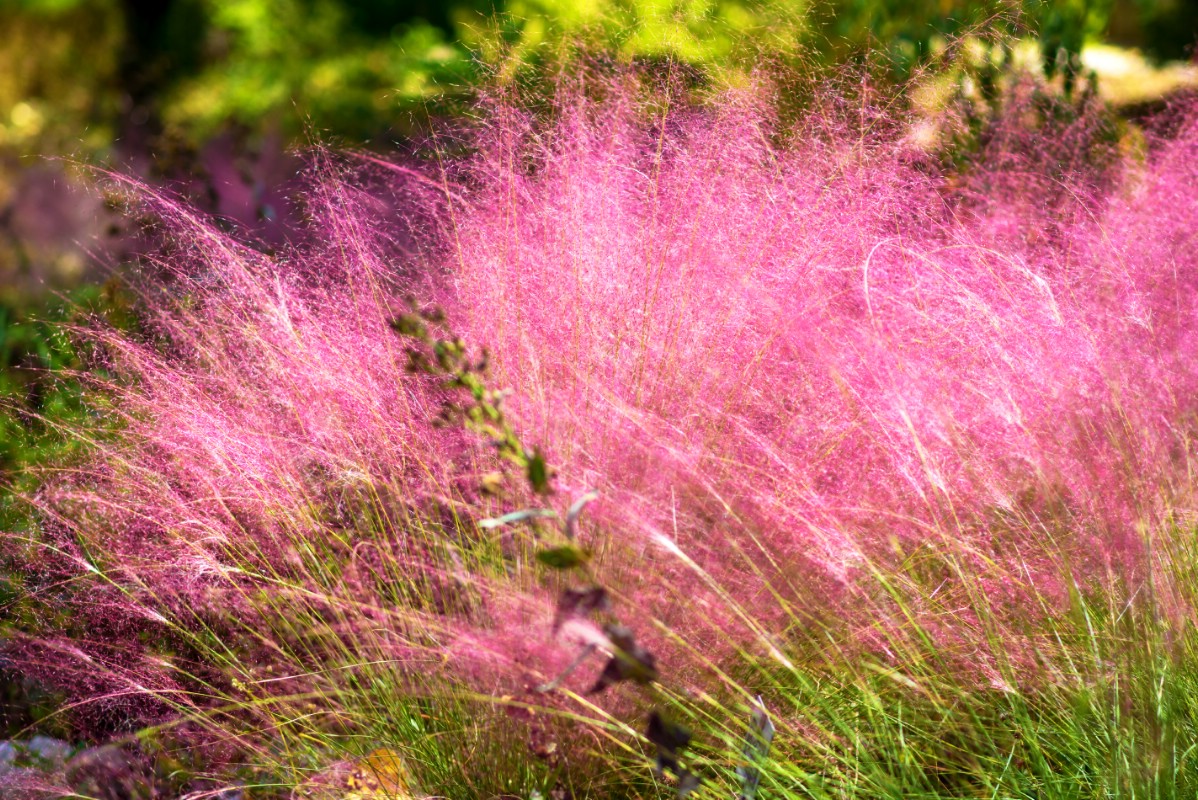
- Botanical name: Muhlenbergia capillaris
- Mature height: 3-4 feet
- Growing conditions: Partial to full sun
- Ideal growing zones: 6-9
- Giant puffballs of cotton-candy pink blooms!so airy you expect a breeze to carry them away! An absolutely showstopping source of late-season color, this native grass is also effortless to grow and...
- Please note: Our shipping occurs only one time for up to 5 items, so please check out all our plants and bulbs to make the most of your shipping dollar
- Zone 6-10.
- This live ornamental grass is unavailable to be shipped to HI and AK - Ships in a pot with soil
- USDA Zones: 6-10 - Mature Size: 18-36" H x 30" W
- Muhlenbergia capillaris
One of the most distinctive ornamental grasses you will ever encounter is Pink Muhly Grass. Once you have seen it, you cannot mistake it for anything else. There are green leaves on the bottom, and slender stems that sprout out with long, wispy plumes of pink flowers.
Whereas a lot of grasses produce plumes or spikelets that are best described as “purplish” or “pinkish,” these plumes of flowers are very pink. Moreover, they are both dense and airy, forming a kind of “cloud” of blossoms for an ethereal effect.
Another reason Pink Muhly Grass is popular is because its flowers are long-lasting. In fact, they can continue to bring color to your landscape until fall ends.
When winter rolls around, the flowers will dry up. At that point, they will no longer be pink, but they will still be pretty, so there is no reason to cut them back.
You can plant Pink Muhly Grass in spring or autumn, but you should wait until spring if the first frost is less than a month away. Leave a few feet between each of your grasses. If you cluster them too closely together, they could develop tar rot, which is a type of fungus.
As a drought-tolerant plant, this ornamental grass can thrive in dry conditions. Moreover, you don’t need to water it all that much. Soil with a low pH is ideal, and saltiness is not a problem. Humidity, however, can be a problem.
As a low-maintenance grass that creates a vibrant, dramatic effect, Pink Muhly Grass is an excellent choice for beginning gardeners who want to bring a stunning transformation to their lawns.
23. Blue Fescue
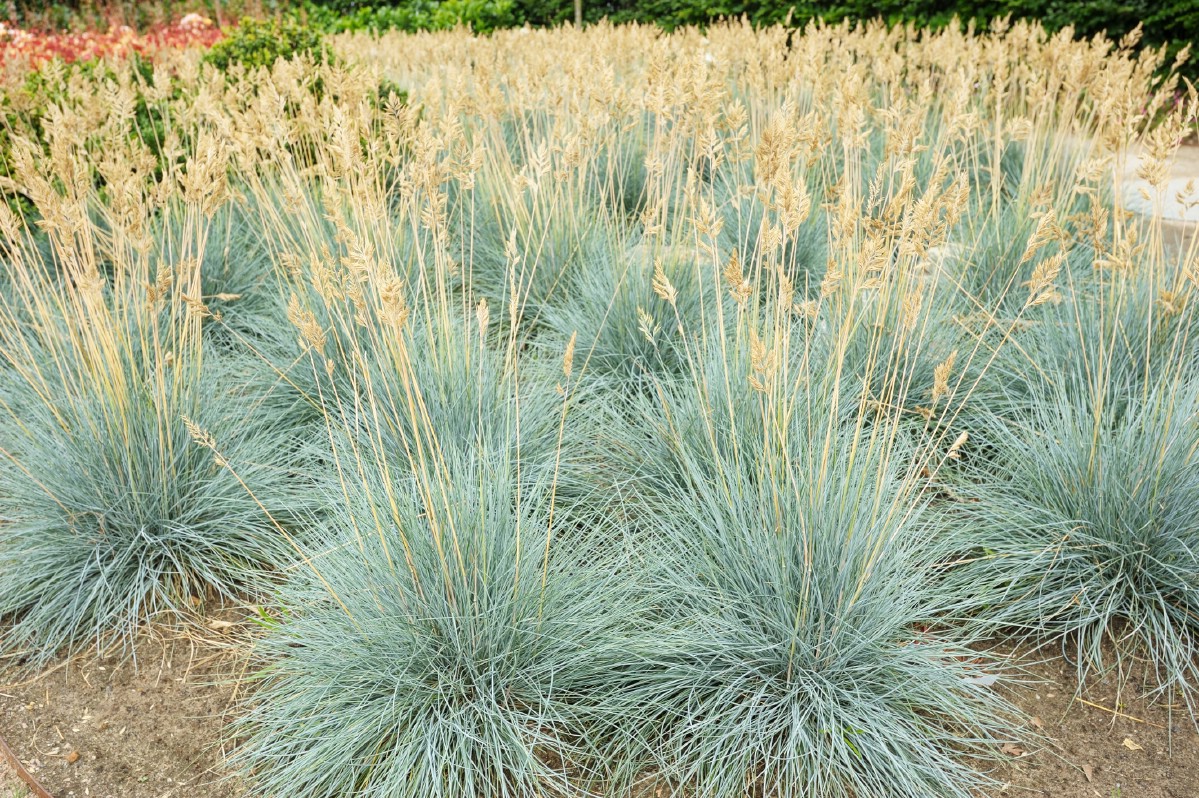
- Botanical name: Festuca glauca
- Mature height: 1 foot
- Growing conditions: Partial to full sun, well-drained soil
- Ideal growing zones: 4-8
- Easy to grow perennial, drought tolerant full sun or full shade
- Strong, robust plants
- Grows 10-12 inches tall
- TWO (2) LARGE LIVE PLANTS – big, healthy, ready to grow, premium perennial flower plants, 4” to 8” tall plants, in 4” pots. NON-GMO No Neonicotinoids
- GROW BLUE FESCUE. Also known as Festuca Elijah Blue, it’s an outstanding perennial ornamental grass that adds interest and silvery blue-green color to your garden. Makes a great edging or...
- GREAT FOUNDATION PLANT. This variety has a low growth, clumping habit with lovely tall, feathery fronds that emerge in the late summer. Makes a great edging or groundcover plant and is a stunning...
Are you looking for an evergreen perennial ornamental grass? Blue Fescue is worth thinking about. This plant does not grow to be very tall, but it forms nice, neat clumps with blueish-green blades. The color stands out beautifully in any season. Thriving in dry climates and enduring droughts with ease, it does sometimes struggle with heat.
If it appears to die in hot weather, trim it. As summer comes to an end, you may notice new growth beginning in fall.
Birds enjoy Blue Fescue, but deer do not, so those are two more pluses.
A popular thing to do with Blue Fescue is to plant it in a rock garden. It can tolerate the dry conditions better than a lot of other plants, and the small clumps are easy to place among the rocks for a pleasing aesthetic effect. Moreover, the year-round color can liven up what would otherwise be rather gray landscaping.
24. Multiplex Bamboo

- Botanical name: Bambusa multiplex
- Mature height: 20-30 feet
- Growing conditions: Partial to full sun
- Ideal growing zones: 7-10
- The perfect non-invasive bamboo for smaller gardens, Golden Goddess has a well-mannered clumping form that can be easily maintained at under 8 feet tall. A fantastic container or screen plant with a...
- Bamboo is among the primary signature plants of Asian inspired gardens. It is also equally at home in tropical island design themes. In the landscape it can be used as a clump of vertical poles for a...
- The clumping, non-invasive habit of Golden Goddess make it an easy, low maintenance choice for homeowners. Pruned properly these plants are spectacular with night lighting trained on their golden...
- Grown, packaged and shipped exclusively by Florida Foliage. Delivering a tropical feel and easy growth that’s non-invasive, the Multiplex Bamboo Plant is a cold hardy, sub-tropical variety that will...
- Nicknamed the Hedge Bamboo or Clumping Bamboo, Multiplex is a fast grower that forms into a dense living wall. But it’s so versatile that you can grow it as an exotic privacy fence or plant it in a...
- No matter where it grows, the yellowish-green Multiplex is perfect for creating a secluded, island-inspired retreat. You can keep it at your desired height easily by pruning just once yearly, meaning...
Looking for another type of bamboo that can grow really tall to serve as a privacy screen? The fast-growing Multiplex Bamboo is worth thinking about. It can get to be 4-6 feet wide when it matures, and as tall as 30 feet. If you plant more than one close together, you can create a wall out of them.
A combination of green and yellow colors makes this plant appealing to the eye. It is also very hardy and can tolerate temperatures down to 10 degrees Fahrenheit.
Ornamental Grasses FAQ
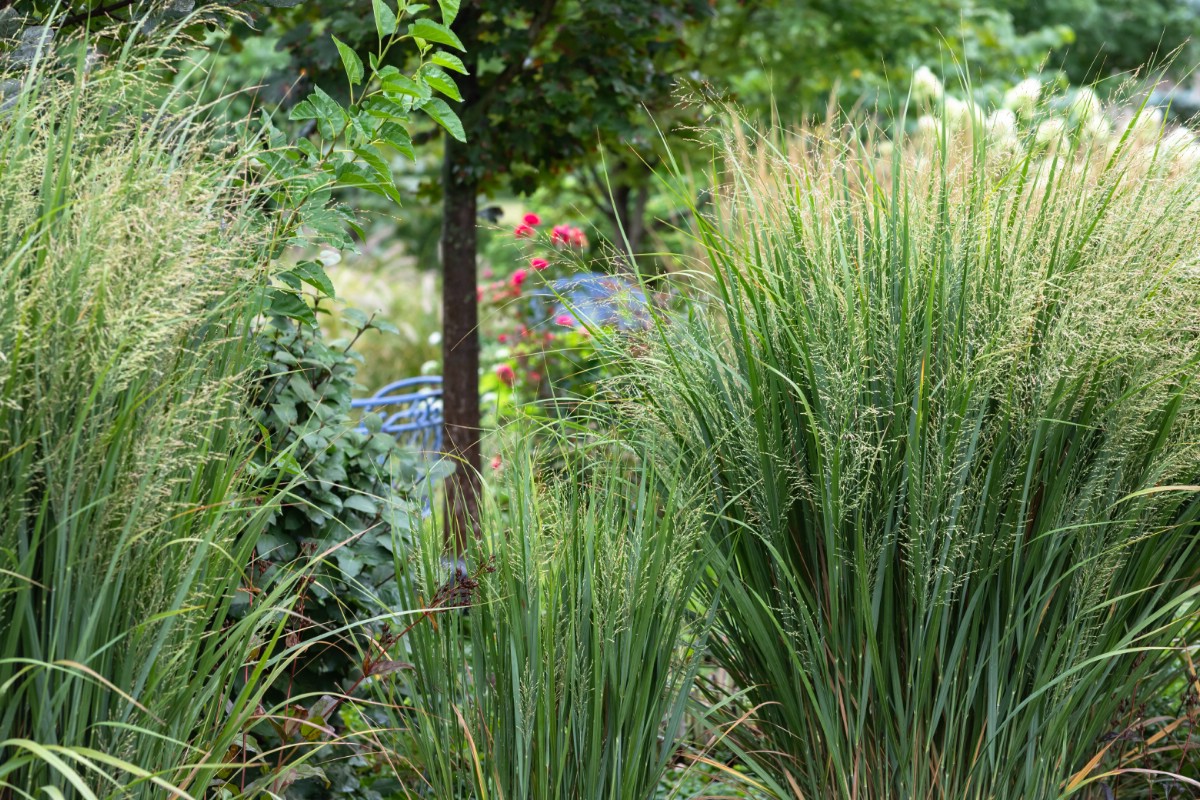
Yes, the majority of ornamental grasses are perennial plants rather than annual plants.
Some are, and some are not.
Many ornamental grasses are not invasive, but there are some that can become so if you let them get out of hand. One example is Liriope spicata. Another is Arundo donax.
Generally, deer do not gravitate toward ornamental grasses. Some examples of grasses that can be considered deer-resistant include Zebra grass, Purple Moor grass, Fountain grass, and Flame grass.
With a couple of exceptions (grass palms and pampas), most ornamental grasses are pet-friendly. It is always wise to look up any plant you are thinking about adding to your yard before doing so to make sure that it will not harm your dog, cat, or other pet.
You will find many drought-resistant ornamental grasses to plant if you live in a dry climate.
Beautify Your Yard with Ornamental Grasses Now
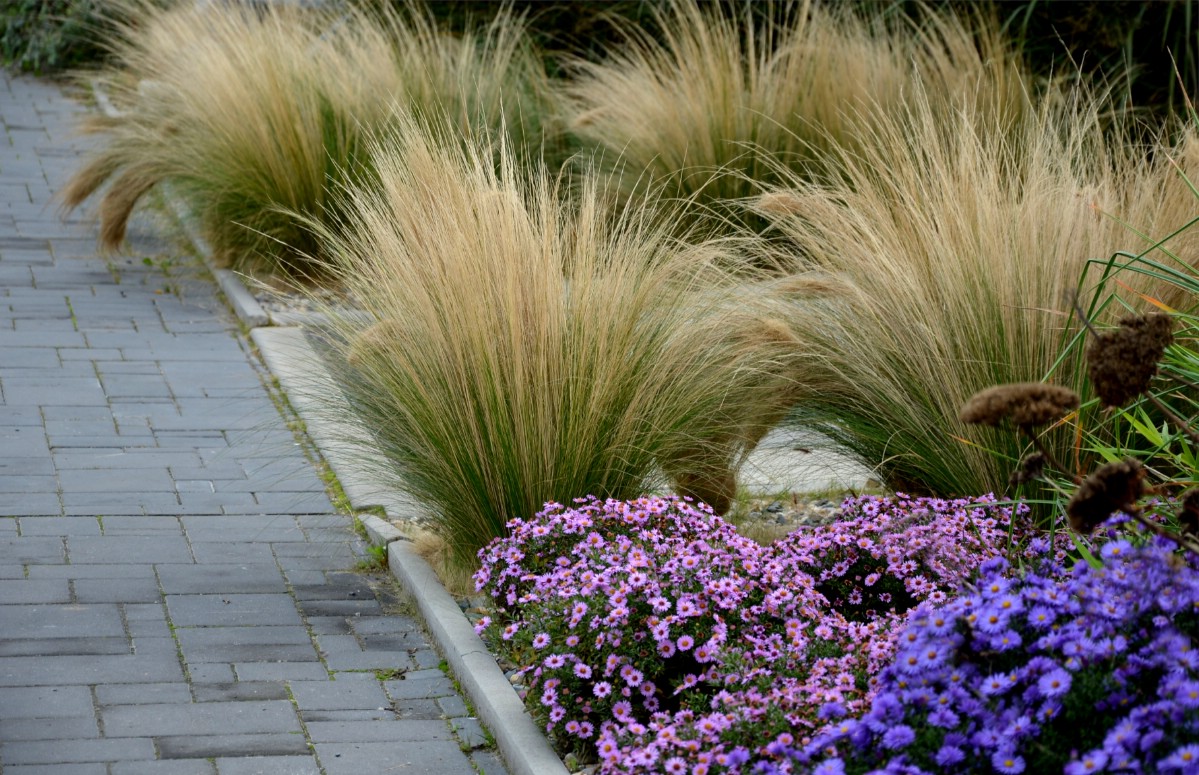
You have now had a chance to discover some of the most stunning ornamental grasses you can plant in your yard. These plants are easy to grow, resistant to drought and deer, safe for pets, and beautiful to enjoy in every season.

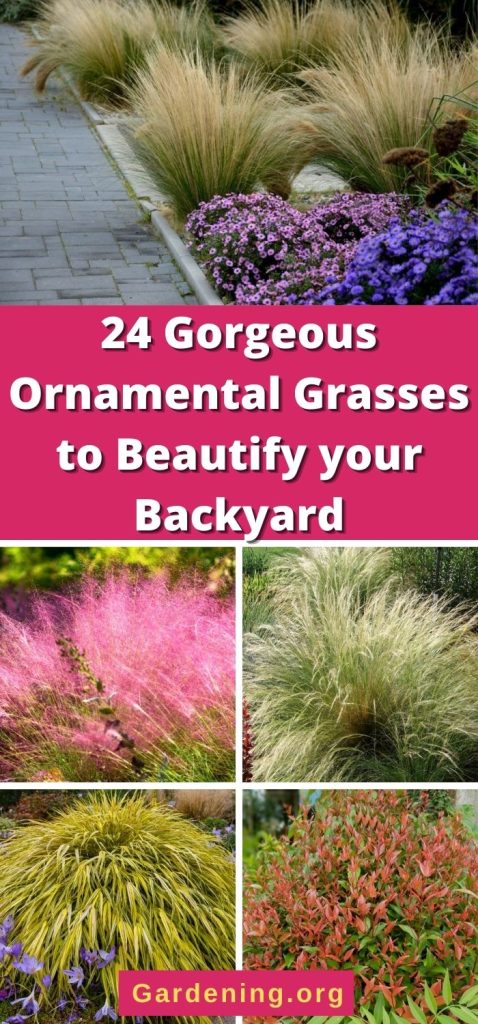
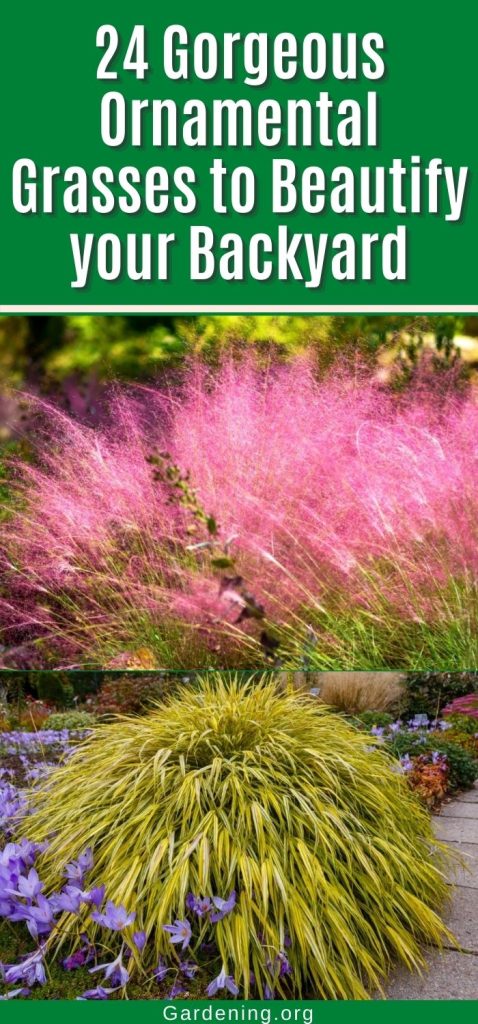
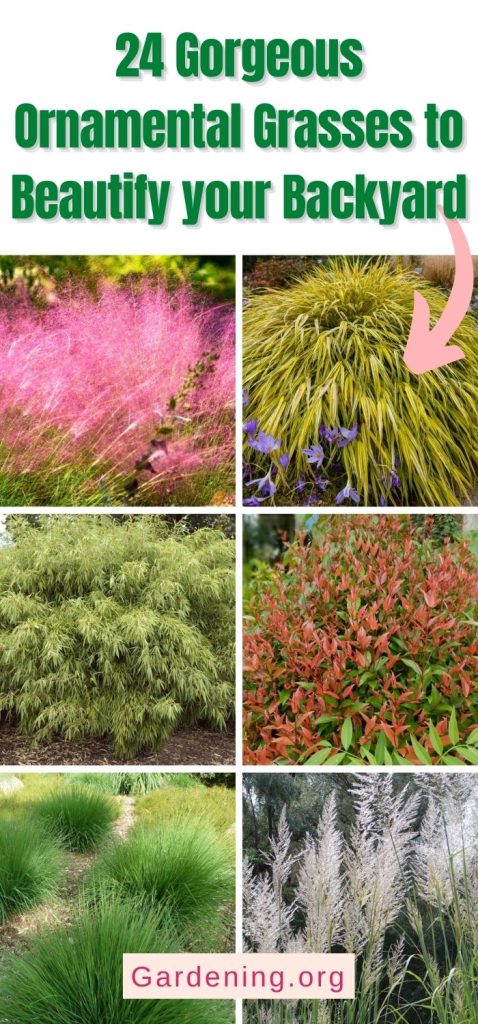
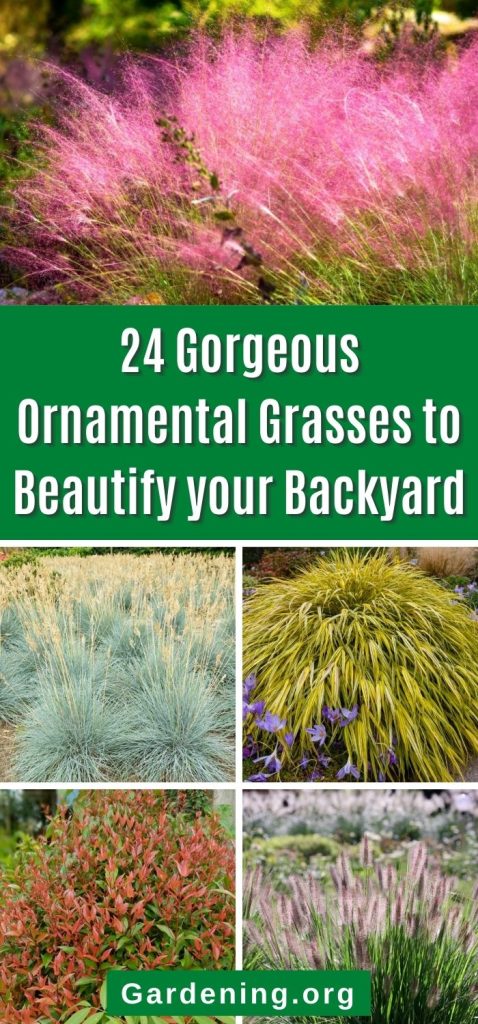







































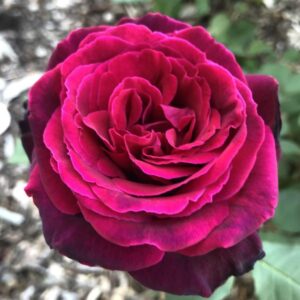
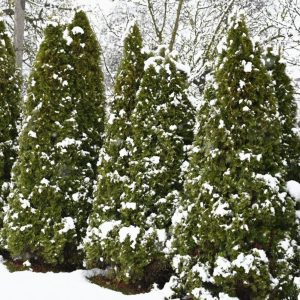


Robert
What is the name of the grass in the picture behind the bench please?
Mary Ward
Pampas grass. Beautiful, yes?